30 Amazing And Disturbing Photos From History's Vaults
Some of the most Influential photographs ever taken, with a little bit of backstory included.
- List View
- Player View
- Grid View
Advertisement
-
1.
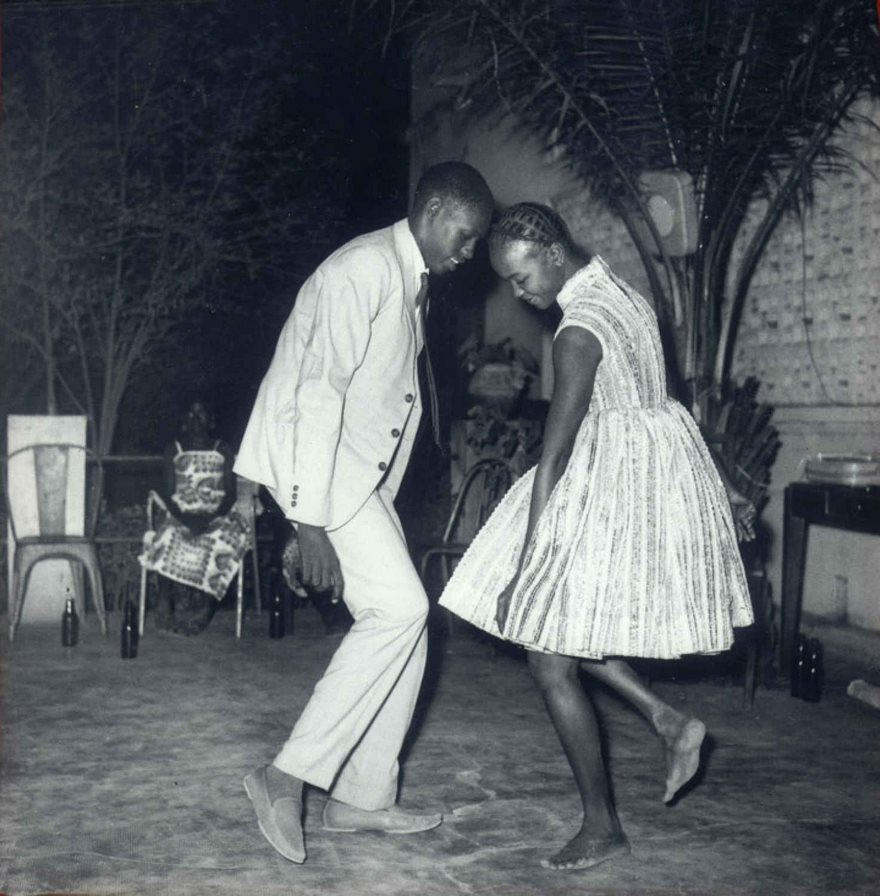 Nuit De Noel, Malick Sidibe, 1963 Malian photographer Malick Sidibé’s life followed the trajectory of his nation. He started out herding his family’s goats, then trained in jewelry making, painting and photography. As French colonial rule ended in 1960, he captured the subtle and profound changes reshaping his nation. Nicknamed the Eye of Bamako, Sidibé took thousands of photos that became a real-time chronicle of the euphoric zeitgeist gripping the capital, a document of a fleeting moment. “Everyone had to have the latest Paris style,” he observed of young people wearing flashy clothes, straddling Vespas and nuzzling in public as they embraced a world without shackles. On Christmas Eve in 1963, Sidibé happened on a young couple at a club, lost in each other’s eyes. What Sidibé called his “talent to observe” allowed him to capture their quiet intimacy, heads brushing as they grace an empty dance floor. “We were entering a new era, and people wanted to dance,” Sidibé said. “Music freed us. Suddenly, young men could get close to young women, hold them in their hands. Before, it was not allowed. And everyone wanted to be photographed dancing up close.”
Nuit De Noel, Malick Sidibe, 1963 Malian photographer Malick Sidibé’s life followed the trajectory of his nation. He started out herding his family’s goats, then trained in jewelry making, painting and photography. As French colonial rule ended in 1960, he captured the subtle and profound changes reshaping his nation. Nicknamed the Eye of Bamako, Sidibé took thousands of photos that became a real-time chronicle of the euphoric zeitgeist gripping the capital, a document of a fleeting moment. “Everyone had to have the latest Paris style,” he observed of young people wearing flashy clothes, straddling Vespas and nuzzling in public as they embraced a world without shackles. On Christmas Eve in 1963, Sidibé happened on a young couple at a club, lost in each other’s eyes. What Sidibé called his “talent to observe” allowed him to capture their quiet intimacy, heads brushing as they grace an empty dance floor. “We were entering a new era, and people wanted to dance,” Sidibé said. “Music freed us. Suddenly, young men could get close to young women, hold them in their hands. Before, it was not allowed. And everyone wanted to be photographed dancing up close.” -
2.
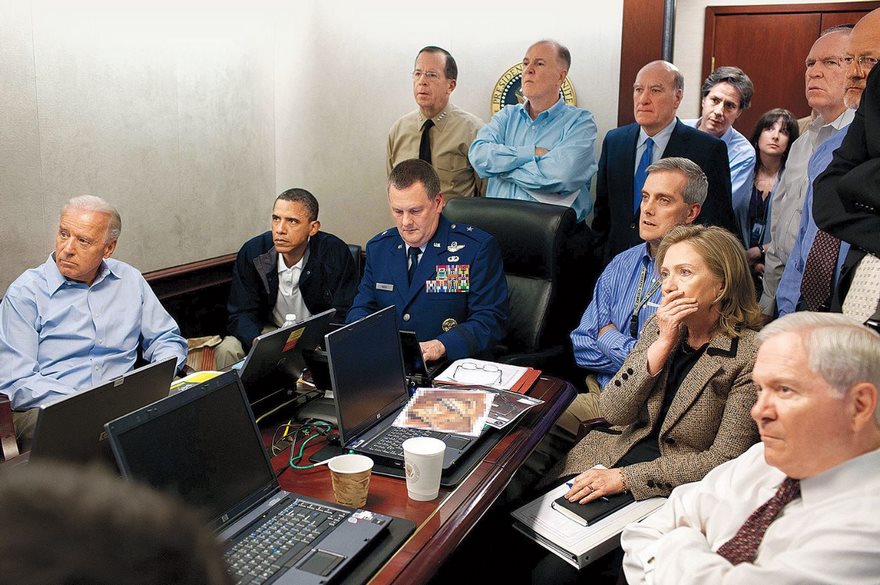 The Situation Room, Pete Souza, 2011 Official White House photographers document Presidents at play and at work, on the phone with world leaders and presiding over Oval Office meetings. But sometimes the unique access allows them to capture watershed moments that become our collective memory. On May 1, 2011, Pete Souza was inside the Situation Room as U.S. forces raided Osama bin Laden’s Pakistan compound and killed the terrorist leader. Yet Souza’s picture includes neither the raid nor bin Laden. Instead he captured those watching the secret operation in real time. President Barack Obama made the decision to launch the attack, but like everyone else in the room, he is a mere spectator to its execution. He stares, brow furrowed, at the raid unfolding on monitors. Secretary of State Hillary Clinton covers her mouth, waiting to see its outcome. In a national address that evening from the White House, Obama announced that bin Laden had been killed. Photographs of the dead body have never been released, leaving Souza’s photo and the tension it captured as the only public image of the mom
The Situation Room, Pete Souza, 2011 Official White House photographers document Presidents at play and at work, on the phone with world leaders and presiding over Oval Office meetings. But sometimes the unique access allows them to capture watershed moments that become our collective memory. On May 1, 2011, Pete Souza was inside the Situation Room as U.S. forces raided Osama bin Laden’s Pakistan compound and killed the terrorist leader. Yet Souza’s picture includes neither the raid nor bin Laden. Instead he captured those watching the secret operation in real time. President Barack Obama made the decision to launch the attack, but like everyone else in the room, he is a mere spectator to its execution. He stares, brow furrowed, at the raid unfolding on monitors. Secretary of State Hillary Clinton covers her mouth, waiting to see its outcome. In a national address that evening from the White House, Obama announced that bin Laden had been killed. Photographs of the dead body have never been released, leaving Souza’s photo and the tension it captured as the only public image of the mom -
3.
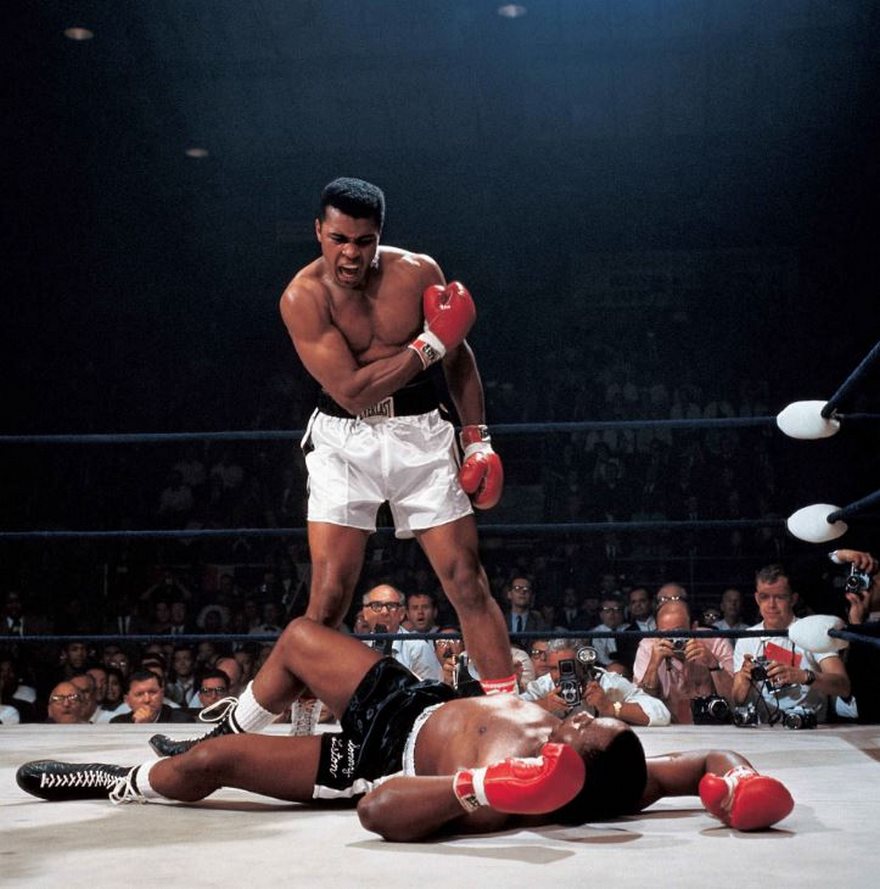 Muhammad Ali Vs. Sonny Liston, Neil Leifer, 1965 So much of great photography is being in the right spot at the right moment. That was what it was like for sports illustrated photographer Neil Leifer when he shot perhaps the greatest sports photo of the century. “I was obviously in the right seat, but what matters is I didn’t miss,” he later said. Leifer had taken that ringside spot in Lewiston, Maine, on May 25, 1965, as 23-year-old heavyweight boxing champion Muhammad Ali squared off against 34-year-old Sonny Liston, the man he’d snatched the title from the previous year. One minute and 44 seconds into the first round, Ali’s right fist connected with Liston’s chin and Liston went down. Leifer snapped the photo of the champ towering over his vanquished opponent and taunting him, “Get up and fight, sucker!” Powerful overhead lights and thick clouds of cigar smoke had turned the ring into the perfect studio, and Leifer took full advantage. His perfectly composed image captures Ali radiating the strength and poetic brashness that made him the nation’s most beloved and reviled athlete, at a moment when sports, politics and popular culture were being squarely battered in the tumult of the ’60s.
Muhammad Ali Vs. Sonny Liston, Neil Leifer, 1965 So much of great photography is being in the right spot at the right moment. That was what it was like for sports illustrated photographer Neil Leifer when he shot perhaps the greatest sports photo of the century. “I was obviously in the right seat, but what matters is I didn’t miss,” he later said. Leifer had taken that ringside spot in Lewiston, Maine, on May 25, 1965, as 23-year-old heavyweight boxing champion Muhammad Ali squared off against 34-year-old Sonny Liston, the man he’d snatched the title from the previous year. One minute and 44 seconds into the first round, Ali’s right fist connected with Liston’s chin and Liston went down. Leifer snapped the photo of the champ towering over his vanquished opponent and taunting him, “Get up and fight, sucker!” Powerful overhead lights and thick clouds of cigar smoke had turned the ring into the perfect studio, and Leifer took full advantage. His perfectly composed image captures Ali radiating the strength and poetic brashness that made him the nation’s most beloved and reviled athlete, at a moment when sports, politics and popular culture were being squarely battered in the tumult of the ’60s. -
4.
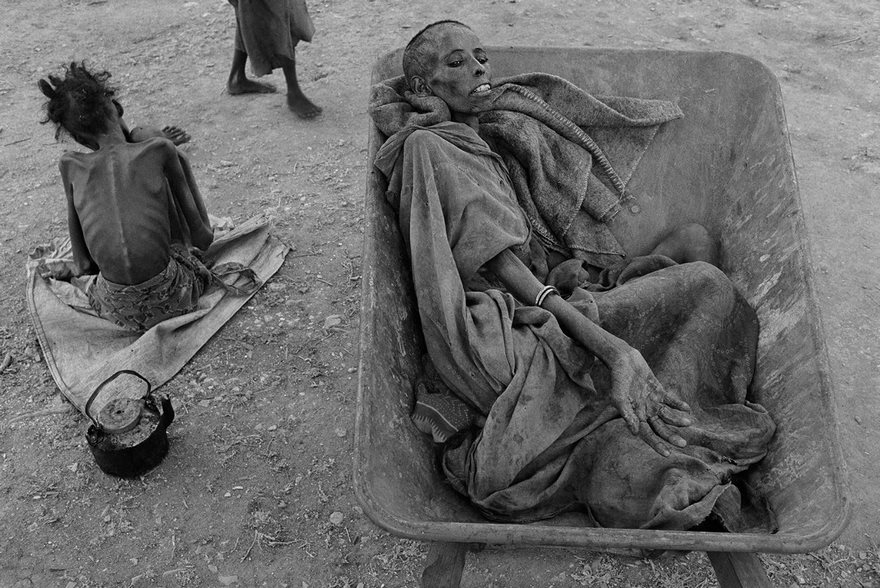 Famine In Somalia, James Nachtwey, 1992 James Nachtwey couldn’t get an assignment in 1992 to document the spiraling famine in Somalia. Mogadishu had become engulfed in armed conflict as food prices soared and international assistance failed to keep pace. Yet few in the West took much notice, so the American photographer went on his own to Somalia, where he received support from the International Committee of the Red Cross. Nachtwey brought back a cache of haunting images, including this scene of a woman waiting to be taken to a feeding center in a wheelbarrow. After it was published as part of a cover feature in the New York Times Magazine, one reader wrote, “Dare we say that it doesn’t get any worse than this?” The world was similarly moved. The Red Cross said public support resulted in what was then its largest operation since World War II. One and a half million people were saved, the ICRC’s Jean-Daniel Tauxe told the Times, and “James’ pictures made the difference.”
Famine In Somalia, James Nachtwey, 1992 James Nachtwey couldn’t get an assignment in 1992 to document the spiraling famine in Somalia. Mogadishu had become engulfed in armed conflict as food prices soared and international assistance failed to keep pace. Yet few in the West took much notice, so the American photographer went on his own to Somalia, where he received support from the International Committee of the Red Cross. Nachtwey brought back a cache of haunting images, including this scene of a woman waiting to be taken to a feeding center in a wheelbarrow. After it was published as part of a cover feature in the New York Times Magazine, one reader wrote, “Dare we say that it doesn’t get any worse than this?” The world was similarly moved. The Red Cross said public support resulted in what was then its largest operation since World War II. One and a half million people were saved, the ICRC’s Jean-Daniel Tauxe told the Times, and “James’ pictures made the difference.” -
5.
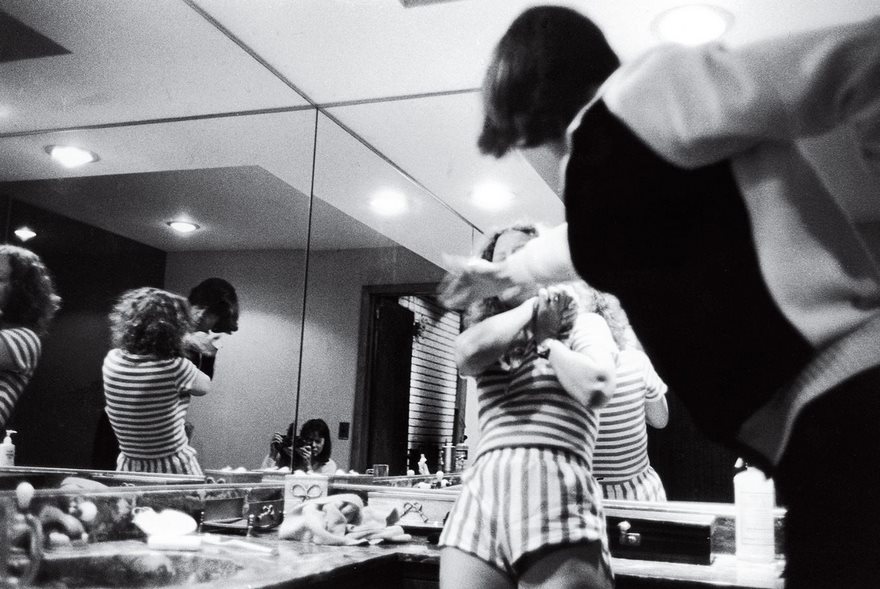 Behind Closed Doors, Donna Ferrato, 1982 There was nothing particularly special about Garth and Lisa or the violence that happened in the bathroom of their suburban New Jersey home one night in 1982. Enraged by a perceived slight, Garth beat his wife while she cowered in a corner. Such acts of intimate-partner violence are not uncommon, but they usually happen in private. This time another person was in the room, photographer Donna Ferrato. Ferrato, who had come to know the couple through a photo project on wealthy swingers, knew that simply bearing witness wasn’t enough. Her shutter clicked again and again. Ferrato approached magazine editors to publish the images, but all refused. So Ferrato did, in her 1991 book Living With the Enemy. The landmark volume chronicled domestic-violence episodes and their aftermaths, including those of the pseudonymous Garth and Lisa. Their real names are Elisabeth and Bengt; his identity was revealed for the first time as part of this project. Ferrato captured incidents and victims while living inside women’s shelters and shadowing police. Her work helped bring violence against women out of the shadows and forced policymakers to confront the issue. In 1994, Congress passed the Violence Against Women Act, increasing penalties against offenders and helping train police to treat it as a serious crime. Thanks to Ferrato, a private tragedy became a public cause.
Behind Closed Doors, Donna Ferrato, 1982 There was nothing particularly special about Garth and Lisa or the violence that happened in the bathroom of their suburban New Jersey home one night in 1982. Enraged by a perceived slight, Garth beat his wife while she cowered in a corner. Such acts of intimate-partner violence are not uncommon, but they usually happen in private. This time another person was in the room, photographer Donna Ferrato. Ferrato, who had come to know the couple through a photo project on wealthy swingers, knew that simply bearing witness wasn’t enough. Her shutter clicked again and again. Ferrato approached magazine editors to publish the images, but all refused. So Ferrato did, in her 1991 book Living With the Enemy. The landmark volume chronicled domestic-violence episodes and their aftermaths, including those of the pseudonymous Garth and Lisa. Their real names are Elisabeth and Bengt; his identity was revealed for the first time as part of this project. Ferrato captured incidents and victims while living inside women’s shelters and shadowing police. Her work helped bring violence against women out of the shadows and forced policymakers to confront the issue. In 1994, Congress passed the Violence Against Women Act, increasing penalties against offenders and helping train police to treat it as a serious crime. Thanks to Ferrato, a private tragedy became a public cause. -
6.
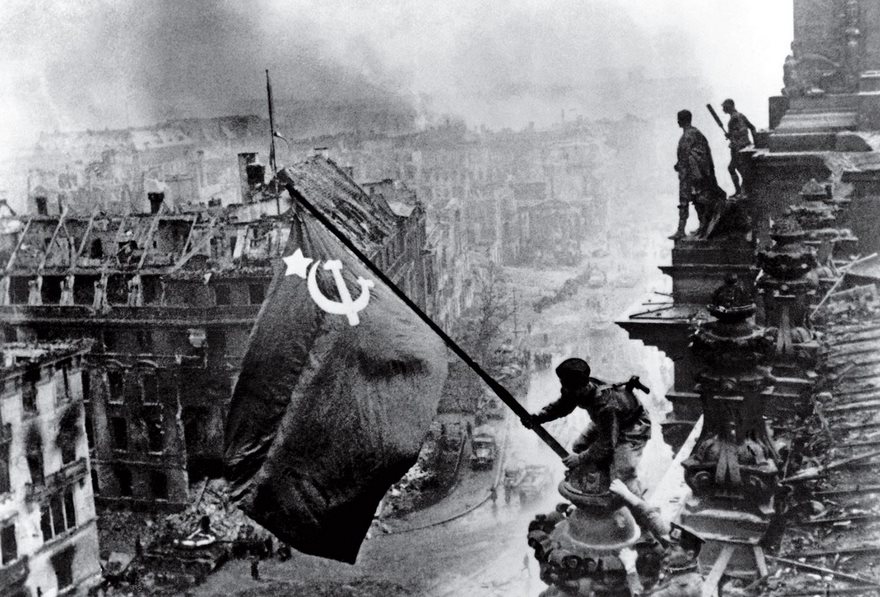 Raising A Flag Over The Reichstag, Yevgeny Khaldei, 1945 “This is what I was waiting for for 1,400 days,” the Ukrainian-born Yevgeny Khaldei said as he gazed at the ruins of Berlin on May 2, 1945. After four years of fighting and photographing across Eastern Europe, the Red Army soldier arrived in the heart of the Nazis’ homeland armed with his Leica III rangefinder and a massive Soviet flag that his uncle, a tailor, had fashioned for him from three red tablecloths. Adolf Hitler had committed suicide two days before, yet the war still raged as Khaldei made his way to the Reichstag. There he told three soldiers to join him, and they clambered up broken stairs onto the parliament building’s blood-soaked parapet. Gazing through his camera, Khaldei knew he had the shot he had hoped for: “I was euphoric.” In printing, Khaldei dramatized the image by intensifying the smoke and darkening the sky—even scratching out part of the negative—to craft a romanticized scene that was part reality, part artifice and all patriotism. Published in the Russian magazine Ogonek, the image became an instant propaganda icon. And no wonder. The flag jutting from the heart of the enemy exalted the nobility of communism, proclaimed the Soviets the new overlords and hinted that by lowering the curtain of war, Premier Joseph Stalin would soon hoist a cold new iron one across the land.
Raising A Flag Over The Reichstag, Yevgeny Khaldei, 1945 “This is what I was waiting for for 1,400 days,” the Ukrainian-born Yevgeny Khaldei said as he gazed at the ruins of Berlin on May 2, 1945. After four years of fighting and photographing across Eastern Europe, the Red Army soldier arrived in the heart of the Nazis’ homeland armed with his Leica III rangefinder and a massive Soviet flag that his uncle, a tailor, had fashioned for him from three red tablecloths. Adolf Hitler had committed suicide two days before, yet the war still raged as Khaldei made his way to the Reichstag. There he told three soldiers to join him, and they clambered up broken stairs onto the parliament building’s blood-soaked parapet. Gazing through his camera, Khaldei knew he had the shot he had hoped for: “I was euphoric.” In printing, Khaldei dramatized the image by intensifying the smoke and darkening the sky—even scratching out part of the negative—to craft a romanticized scene that was part reality, part artifice and all patriotism. Published in the Russian magazine Ogonek, the image became an instant propaganda icon. And no wonder. The flag jutting from the heart of the enemy exalted the nobility of communism, proclaimed the Soviets the new overlords and hinted that by lowering the curtain of war, Premier Joseph Stalin would soon hoist a cold new iron one across the land. -
7.
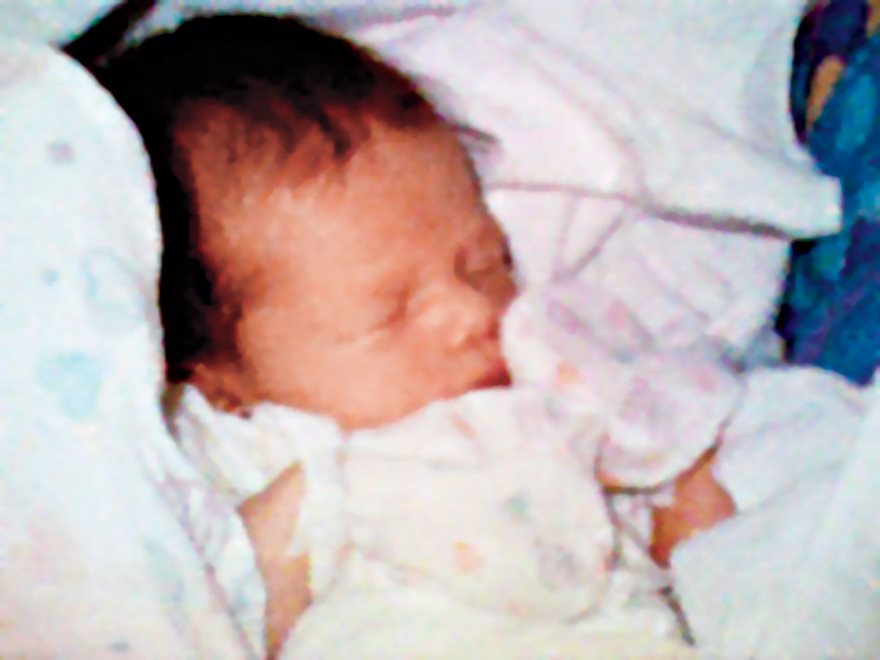 First Cell-Phone Picture, Philippe Kahn, 1997 Boredom can be a powerful incentive. In 1997, Philippe Kahn was stuck in a Northern California maternity ward with nothing to do. The software entrepreneur had been shooed away by his wife while she birthed their daughter, Sophie. So Kahn, who had been tinkering with technologies that share images instantly, jerry-built a device that could send a photo of his newborn to friends and family—in real time. Like any invention, the setup was crude: a digital camera connected to his flip-top cell phone, synched by a few lines of code he’d written on his laptop in the hospital. But the effect has transformed the world: Kahn’s device captured his daughter’s first moments and transmitted them instantly to more than 2,000 people. Kahn soon refined his ad hoc prototype, and in 2000 Sharp used his technology to release the first commercially available integrated camera phone, in Japan. The phones were introduced to the U.S. market a few years later and soon became ubiquitous. Kahn’s invention forever altered how we communicate, perceive and experience the world and laid the groundwork for smartphones and photo-sharing applications like Instagram and Snapchat. Phones are now used to send hundreds of millions of images around the world every day—including a fair number of baby pictures.
First Cell-Phone Picture, Philippe Kahn, 1997 Boredom can be a powerful incentive. In 1997, Philippe Kahn was stuck in a Northern California maternity ward with nothing to do. The software entrepreneur had been shooed away by his wife while she birthed their daughter, Sophie. So Kahn, who had been tinkering with technologies that share images instantly, jerry-built a device that could send a photo of his newborn to friends and family—in real time. Like any invention, the setup was crude: a digital camera connected to his flip-top cell phone, synched by a few lines of code he’d written on his laptop in the hospital. But the effect has transformed the world: Kahn’s device captured his daughter’s first moments and transmitted them instantly to more than 2,000 people. Kahn soon refined his ad hoc prototype, and in 2000 Sharp used his technology to release the first commercially available integrated camera phone, in Japan. The phones were introduced to the U.S. market a few years later and soon became ubiquitous. Kahn’s invention forever altered how we communicate, perceive and experience the world and laid the groundwork for smartphones and photo-sharing applications like Instagram and Snapchat. Phones are now used to send hundreds of millions of images around the world every day—including a fair number of baby pictures. -
8.
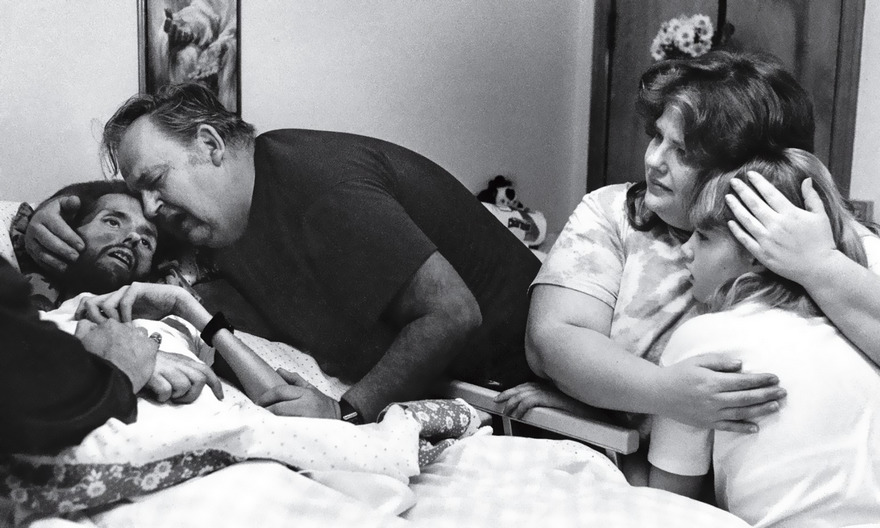 The Face Of Aids, Therese Frare, 1990 David Kirby died surrounded by his family. But Therese Frare’s photograph of the 32-year-old man on his deathbed did more than just capture the heartbreaking moment. It humanized AIDS, the disease that killed Kirby, at a time when it was ravaging victims largely out of public view. Frare’s photograph, published in LIFE in 1990, showed how the widely misunderstood disease devastated more than just its victims. It would be another year before the red ribbon became a symbol of compassion and resilience, and three years before President Bill Clinton created a White House Office of National AIDS Policy. In 1992 the clothing company Benetton used a colorized version of Frare’s photograph in a series of provocative ads. Many magazines refused to run it, and a range of groups called for a boycott. But Kirby’s family consented to its use, believing that the ad helped raise critical awareness about AIDS at a moment when the disease was still uncontrolled and sufferers were lobbying the federal government to speed the development of new drugs. “We just felt it was time that people saw the truth about AIDS,” Kirby’s mother Kay said. Thanks to Frare’s image, they did.
The Face Of Aids, Therese Frare, 1990 David Kirby died surrounded by his family. But Therese Frare’s photograph of the 32-year-old man on his deathbed did more than just capture the heartbreaking moment. It humanized AIDS, the disease that killed Kirby, at a time when it was ravaging victims largely out of public view. Frare’s photograph, published in LIFE in 1990, showed how the widely misunderstood disease devastated more than just its victims. It would be another year before the red ribbon became a symbol of compassion and resilience, and three years before President Bill Clinton created a White House Office of National AIDS Policy. In 1992 the clothing company Benetton used a colorized version of Frare’s photograph in a series of provocative ads. Many magazines refused to run it, and a range of groups called for a boycott. But Kirby’s family consented to its use, believing that the ad helped raise critical awareness about AIDS at a moment when the disease was still uncontrolled and sufferers were lobbying the federal government to speed the development of new drugs. “We just felt it was time that people saw the truth about AIDS,” Kirby’s mother Kay said. Thanks to Frare’s image, they did. -
9.
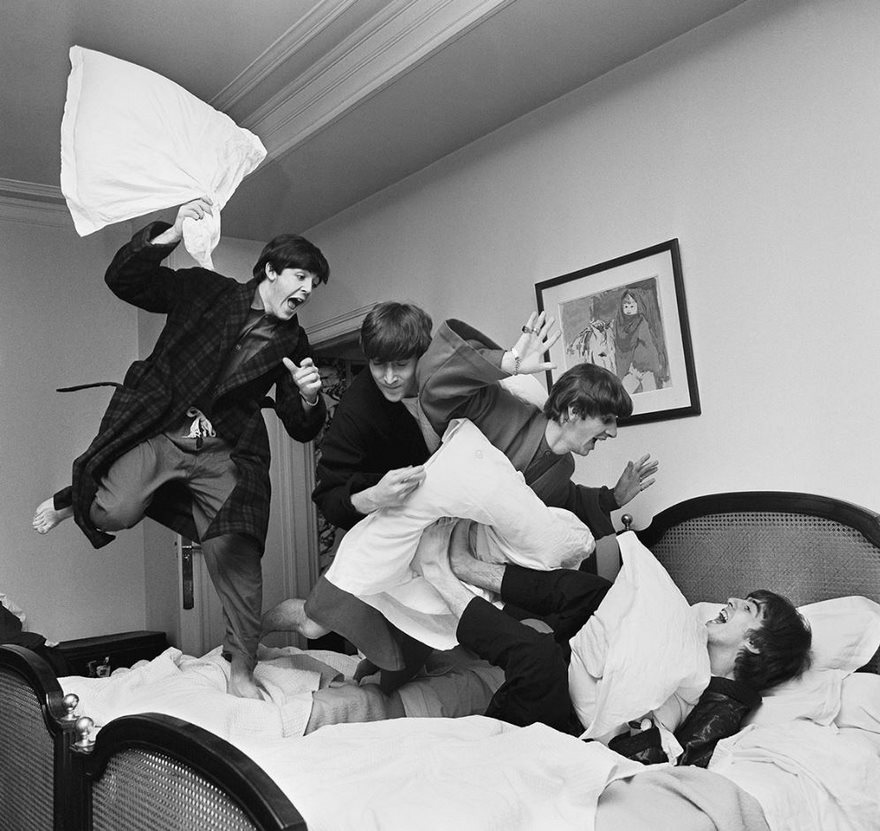 The Pillow Fight, Harry Benson, 1964 Harry Benson didn’t want to meet the Beatles. The Glasgow-born photographer had plans to cover a news story in Africa when he was assigned to photograph the musicians in Paris. “I took myself for a serious journalist and I didn’t want to cover a rock ’n’ roll story,” he scoffed. But once he met the boys from Liverpool and heard them play, Benson had no desire to leave. “I thought, ‘God, I’m on the right story.’ ” The Beatles were on the cusp of greatness, and Benson was in the middle of it. His pillow-fight photo, taken in the swanky George V Hotel the night the band found out “I Want to Hold Your Hand” hit No. 1 in the U.S., freezes John, Paul, George and Ringo in an exuberant cascade of boyish talent—and perhaps their last moment of unbridled innocence. It captures the sheer joy, happiness and optimism that would be embraced as Beatlemania and that helped lift America’s morale just 11 weeks after John F. Kennedy’s assassination. The following month, Benson accompanied the Fab Four as they flew to New York City to appear on The Ed Sullivan Show, kick-starting the British Invasion. The trip led to decades of collaboration with the group and, as Benson later recalled, “I was so close to not being there.”
The Pillow Fight, Harry Benson, 1964 Harry Benson didn’t want to meet the Beatles. The Glasgow-born photographer had plans to cover a news story in Africa when he was assigned to photograph the musicians in Paris. “I took myself for a serious journalist and I didn’t want to cover a rock ’n’ roll story,” he scoffed. But once he met the boys from Liverpool and heard them play, Benson had no desire to leave. “I thought, ‘God, I’m on the right story.’ ” The Beatles were on the cusp of greatness, and Benson was in the middle of it. His pillow-fight photo, taken in the swanky George V Hotel the night the band found out “I Want to Hold Your Hand” hit No. 1 in the U.S., freezes John, Paul, George and Ringo in an exuberant cascade of boyish talent—and perhaps their last moment of unbridled innocence. It captures the sheer joy, happiness and optimism that would be embraced as Beatlemania and that helped lift America’s morale just 11 weeks after John F. Kennedy’s assassination. The following month, Benson accompanied the Fab Four as they flew to New York City to appear on The Ed Sullivan Show, kick-starting the British Invasion. The trip led to decades of collaboration with the group and, as Benson later recalled, “I was so close to not being there.” -
10.
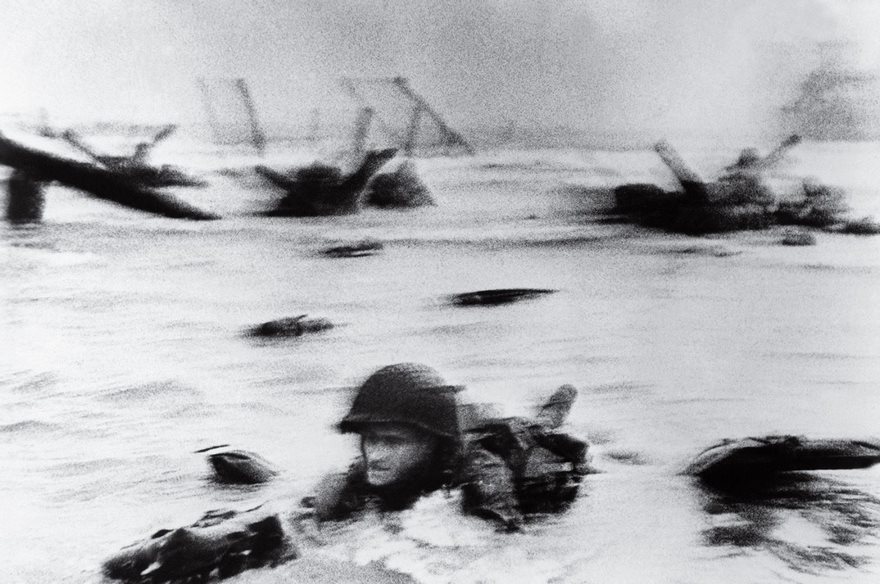 D-Day, Robert Capa, 1944 It was the invasion to save civilization, and LIFE’s Robert Capa was there, the only still photographer to wade with the 34,250 troops onto Omaha Beach during the D-Day landing. His photographs—infused with jarring movement from the center of that brutal assault—gave the public an American soldier’s view of the dangers of war. The soldier in this case was Private First Class Huston Riley, who after the Nazis shelled his landing craft jumped into water so deep that he had to walk along the bottom until he could hold his breath no more. When he activated his Navy M-26 belt life preservers and floated to the surface, Riley became a target for the guns and artillery shells mowing down his comrades. Struck several times, the 22-year-old soldier took about half an hour to reach the Normandy shore. Capa took this photo of him in the surf and then with the assistance of a sergeant helped Riley, who later recalled thinking, “What the hell is this guy doing here? I can’t believe it. Here’s a cameraman on the shore.” Capa spent an hour and a half under fire as men around him died. A courier then transported his four rolls of film to LIFE’s London offices, and the magazine’s general manager stopped the presses to get them into the June 19 issue. Most of the film, though, showed no images after processing, and only some frames survived. The remaining images have a grainy, blurry look that gives them the frenetic feel of action, a quality that has come to define our collective memory of that epic clash.
D-Day, Robert Capa, 1944 It was the invasion to save civilization, and LIFE’s Robert Capa was there, the only still photographer to wade with the 34,250 troops onto Omaha Beach during the D-Day landing. His photographs—infused with jarring movement from the center of that brutal assault—gave the public an American soldier’s view of the dangers of war. The soldier in this case was Private First Class Huston Riley, who after the Nazis shelled his landing craft jumped into water so deep that he had to walk along the bottom until he could hold his breath no more. When he activated his Navy M-26 belt life preservers and floated to the surface, Riley became a target for the guns and artillery shells mowing down his comrades. Struck several times, the 22-year-old soldier took about half an hour to reach the Normandy shore. Capa took this photo of him in the surf and then with the assistance of a sergeant helped Riley, who later recalled thinking, “What the hell is this guy doing here? I can’t believe it. Here’s a cameraman on the shore.” Capa spent an hour and a half under fire as men around him died. A courier then transported his four rolls of film to LIFE’s London offices, and the magazine’s general manager stopped the presses to get them into the June 19 issue. Most of the film, though, showed no images after processing, and only some frames survived. The remaining images have a grainy, blurry look that gives them the frenetic feel of action, a quality that has come to define our collective memory of that epic clash. -
11.
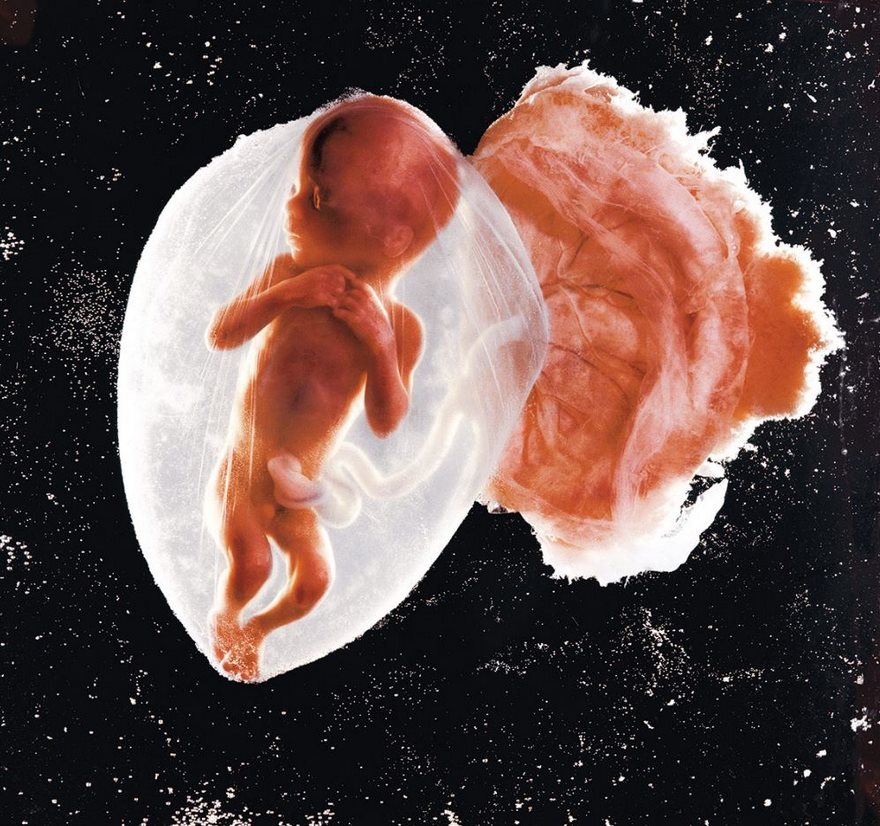 Fetus, 18 Weeks, Lennart Nilsson, 1965 When LIFE published Lennart Nilsson’s photo essay “Drama of Life Before Birth” in 1965, the issue was so popular that it sold out within days. And for good reason. Nilsson’s images publicly revealed for the first time what a developing fetus looks like, and in the process raised pointed new questions about when life begins. In the accompanying story, LIFE explained that all but one of the fetuses pictured were photographed outside the womb and had been removed—or aborted—“for a variety of medical reasons.” Nilsson had struck a deal with a hospital in Stockholm, whose doctors called him whenever a fetus was available to photograph. There, in a dedicated room with lights and lenses specially designed for the project, Nilsson arranged the fetuses so they appeared to be floating as if in the womb. In the years since Nilsson’s essay was published, the images have been widely appropriated without his permission. Antiabortion activists in particular have used them to advance their cause. (Nilsson has never taken a public stand on abortion.) Still, decades after they first appeared, Nilsson’s images endure for their unprecedentedly clear, detailed view of human life at its earliest stages.
Fetus, 18 Weeks, Lennart Nilsson, 1965 When LIFE published Lennart Nilsson’s photo essay “Drama of Life Before Birth” in 1965, the issue was so popular that it sold out within days. And for good reason. Nilsson’s images publicly revealed for the first time what a developing fetus looks like, and in the process raised pointed new questions about when life begins. In the accompanying story, LIFE explained that all but one of the fetuses pictured were photographed outside the womb and had been removed—or aborted—“for a variety of medical reasons.” Nilsson had struck a deal with a hospital in Stockholm, whose doctors called him whenever a fetus was available to photograph. There, in a dedicated room with lights and lenses specially designed for the project, Nilsson arranged the fetuses so they appeared to be floating as if in the womb. In the years since Nilsson’s essay was published, the images have been widely appropriated without his permission. Antiabortion activists in particular have used them to advance their cause. (Nilsson has never taken a public stand on abortion.) Still, decades after they first appeared, Nilsson’s images endure for their unprecedentedly clear, detailed view of human life at its earliest stages. -
12.
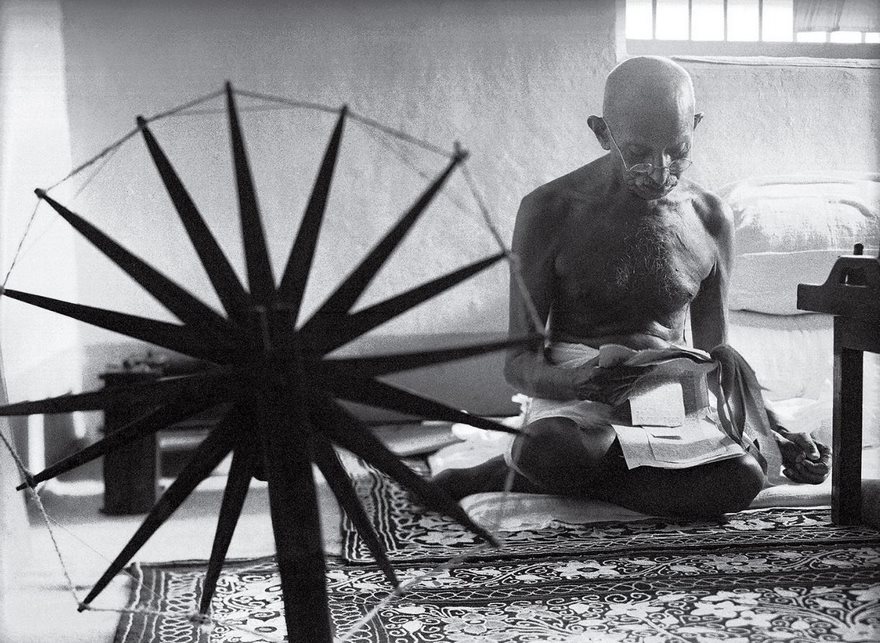 Gandhi And The Spinning Wheel, Margaret Bourke-White, 1946 When the British held Mohandas Gandhi prisoner at Yeravda prison in Pune, India, from 1932 to 1933, the nationalist leader made his own thread with a charkha, a portable spinning wheel. The practice evolved from a source of personal comfort during captivity into a touchstone of the campaign for independence, with Gandhi encouraging his countrymen to make their own homespun cloth instead of buying British goods. By the time Margaret Bourke-White came to Gandhi’s compound for a life article on India’s leaders, spinning was so bound up with Gandhi’s identity that his secretary, Pyarelal Nayyar, told Bourke-White that she had to learn the craft before photographing the leader. Bourke-White’s picture of Gandhi reading the news alongside his charkha never appeared in the article for which it was taken, but less than two years later life featured the photo prominently in a tribute published after Gandhi’s assassination. It soon became an indelible image, the slain civil-disobedience crusader with his most potent symbol, and helped solidify the perception of Gandhi outside the subcontinent as a saintly man of peace.
Gandhi And The Spinning Wheel, Margaret Bourke-White, 1946 When the British held Mohandas Gandhi prisoner at Yeravda prison in Pune, India, from 1932 to 1933, the nationalist leader made his own thread with a charkha, a portable spinning wheel. The practice evolved from a source of personal comfort during captivity into a touchstone of the campaign for independence, with Gandhi encouraging his countrymen to make their own homespun cloth instead of buying British goods. By the time Margaret Bourke-White came to Gandhi’s compound for a life article on India’s leaders, spinning was so bound up with Gandhi’s identity that his secretary, Pyarelal Nayyar, told Bourke-White that she had to learn the craft before photographing the leader. Bourke-White’s picture of Gandhi reading the news alongside his charkha never appeared in the article for which it was taken, but less than two years later life featured the photo prominently in a tribute published after Gandhi’s assassination. It soon became an indelible image, the slain civil-disobedience crusader with his most potent symbol, and helped solidify the perception of Gandhi outside the subcontinent as a saintly man of peace. -
13.
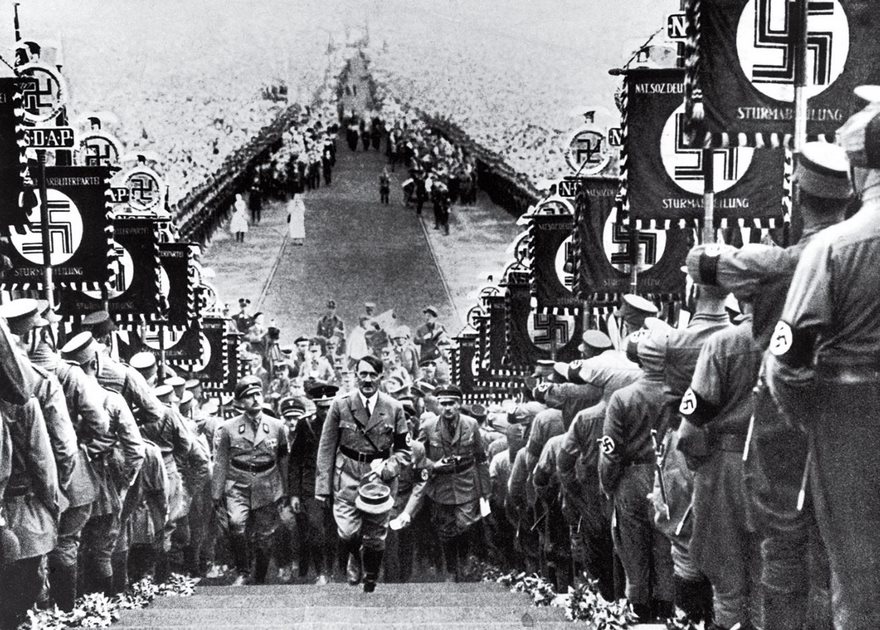 Hitler At A Nazi Party Rally, Heinrich Hoffmann, 1934 Spectacle was like oxygen for the Nazis, and Heinrich Hoffmann was instrumental in staging Hitler’s growing pageant of power. Hoffmann, who joined the party in 1920 and became Hitler’s personal photographer and confidant, was charged with choreographing the regime’s propaganda carnivals and selling them to a wounded German public. Nowhere did Hoffmann do it better than on September 30, 1934, in his rigidly symmetrical photo at the Bückeberg Harvest Festival, where the Mephistophelian Führer swaggers at the center of a grand Wagnerian fantasy of adoring and heiling troops. By capturing this and so many other extravaganzas, Hoffmann—who took more than 2 million photos of his boss—fed the regime’s vast propaganda machine and spread its demonic dream. Such images were all-pervasive in Hitler’s Reich, which shrewdly used Hoffman’s photos, the stark graphics on Nazi banners and the films of Leni Riefenstahl to make Aryanism seem worthy of godlike worship. Humiliated by World War I, punishing reparations and the Great Depression, a nation eager to reclaim its sense of self was rallied by Hitler’s visage and his seemingly invincible men aching to right wrongs. Hoffmann’s expertly rendered propaganda is a testament to photography’s power to move nations and plunge a world into war.
Hitler At A Nazi Party Rally, Heinrich Hoffmann, 1934 Spectacle was like oxygen for the Nazis, and Heinrich Hoffmann was instrumental in staging Hitler’s growing pageant of power. Hoffmann, who joined the party in 1920 and became Hitler’s personal photographer and confidant, was charged with choreographing the regime’s propaganda carnivals and selling them to a wounded German public. Nowhere did Hoffmann do it better than on September 30, 1934, in his rigidly symmetrical photo at the Bückeberg Harvest Festival, where the Mephistophelian Führer swaggers at the center of a grand Wagnerian fantasy of adoring and heiling troops. By capturing this and so many other extravaganzas, Hoffmann—who took more than 2 million photos of his boss—fed the regime’s vast propaganda machine and spread its demonic dream. Such images were all-pervasive in Hitler’s Reich, which shrewdly used Hoffman’s photos, the stark graphics on Nazi banners and the films of Leni Riefenstahl to make Aryanism seem worthy of godlike worship. Humiliated by World War I, punishing reparations and the Great Depression, a nation eager to reclaim its sense of self was rallied by Hitler’s visage and his seemingly invincible men aching to right wrongs. Hoffmann’s expertly rendered propaganda is a testament to photography’s power to move nations and plunge a world into war. -
14.
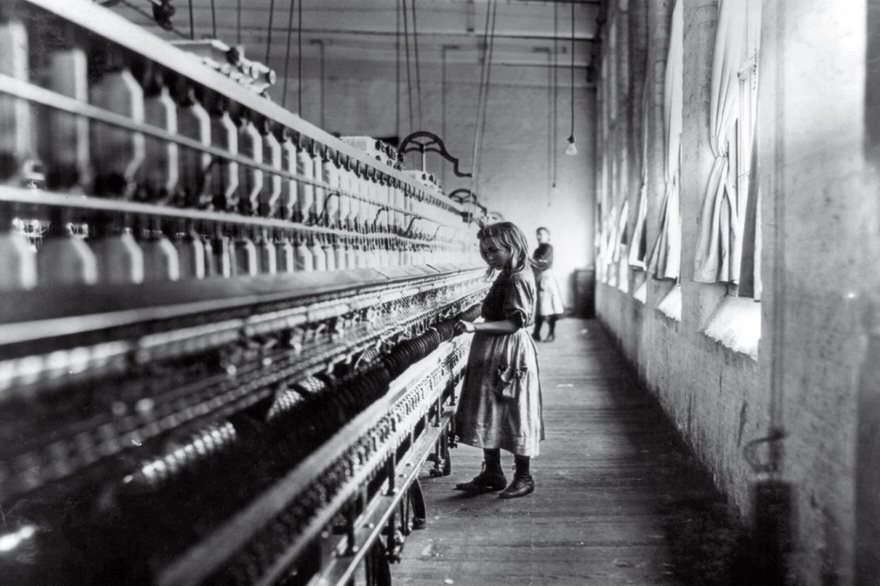 Cotton Mill Girl, Lewis Hine, 1908 Working as an investigative photographer for the National Child Labor Committee, Lewis Hine believed that images of child labor would force citizens to demand change. The muckraker conned his way into mills and factories from Massachusetts to South Carolina by posing as a Bible seller, insurance agent or industrial photographer in order to tell the plight of nearly 2 million children. Carting around a large-format camera and jotting down information in a hidden notebook, Hine recorded children laboring in meatpacking houses, coal mines and canneries, and in November 1908 he came upon Sadie Pfeifer, who embodied the world he exposed. A 48-inch-tall wisp of a girl, she was “one of the many small children at work” manning a gargantuan cotton-spinning machine in Lancaster, S.C. Since Hine often had to lie to get his shots, he made “double-sure that my photo data was 100% pure—no retouching or fakery of any kind.” His images of children as young as 8 dwarfed by the cogs of a cold, mechanized universe squarely set the horrors of child labor before the public, leading to regulatory legislation and cutting the number of child laborers nearly in half from 1910 to 1920.
Cotton Mill Girl, Lewis Hine, 1908 Working as an investigative photographer for the National Child Labor Committee, Lewis Hine believed that images of child labor would force citizens to demand change. The muckraker conned his way into mills and factories from Massachusetts to South Carolina by posing as a Bible seller, insurance agent or industrial photographer in order to tell the plight of nearly 2 million children. Carting around a large-format camera and jotting down information in a hidden notebook, Hine recorded children laboring in meatpacking houses, coal mines and canneries, and in November 1908 he came upon Sadie Pfeifer, who embodied the world he exposed. A 48-inch-tall wisp of a girl, she was “one of the many small children at work” manning a gargantuan cotton-spinning machine in Lancaster, S.C. Since Hine often had to lie to get his shots, he made “double-sure that my photo data was 100% pure—no retouching or fakery of any kind.” His images of children as young as 8 dwarfed by the cogs of a cold, mechanized universe squarely set the horrors of child labor before the public, leading to regulatory legislation and cutting the number of child laborers nearly in half from 1910 to 1920. -
15.
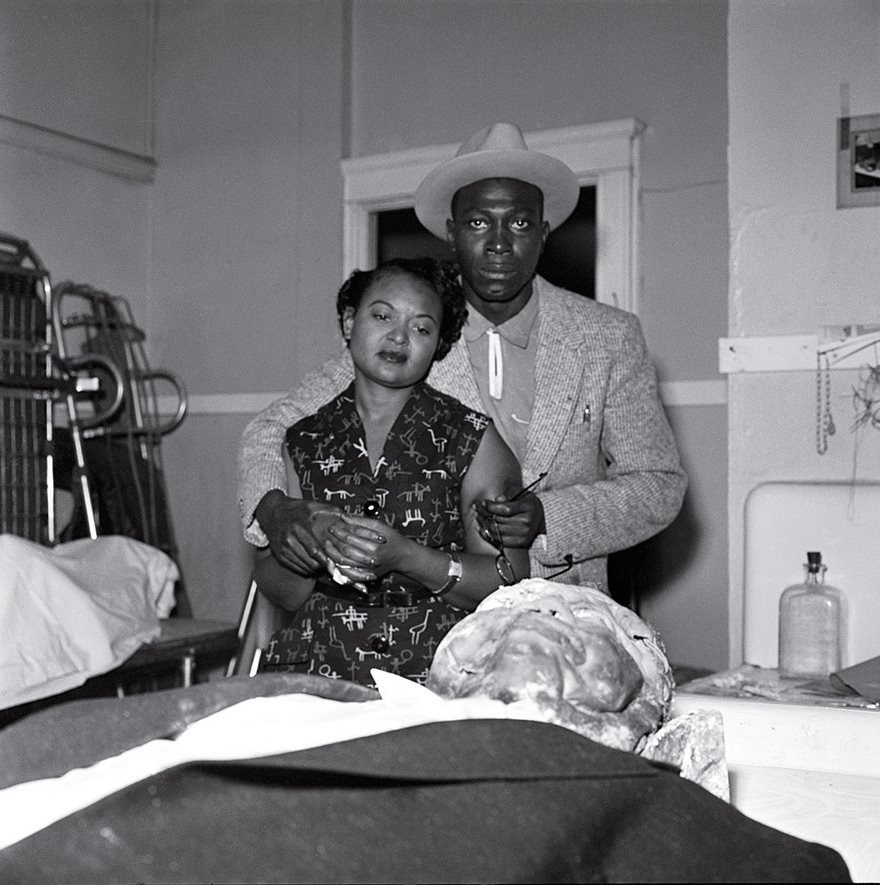 Emmett Till, David Jackson, 1955 In August 1955, Emmett Till, a black teenager from Chicago, was visiting relatives in Mississippi when he stopped at Bryant’s Grocery and Meat Market. There he encountered Carolyn Bryant, a white woman. Whether Till really flirted with Bryant or whistled at her isn’t known. But what happened four days later is. Bryant’s husband Roy and his half brother, J.W. Milam, seized the 14-year-old from his great-uncle’s house. The pair then beat Till, shot him, and strung barbed wire and a 75-pound metal fan around his neck and dumped the lifeless body in the Tallahatchie River. A white jury quickly acquitted the men, with one juror saying it had taken so long only because they had to break to drink some pop. When Till’s mother Mamie came to identify her son, she told the funeral director, “Let the people see what I’ve seen.” She brought him home to Chicago and insisted on an open casket. Tens of thousands filed past Till’s remains, but it was the publication of the searing funeral image in Jet, with a stoic Mamie gazing at her murdered child’s ravaged body, that forced the world to reckon with the brutality of American racism. For almost a century, African Americans were lynched with regularity and impunity. Now, thanks to a mother’s determination to expose the barbarousness of the crime, the public could no longer pretend to ignore what they couldn’t see.
Emmett Till, David Jackson, 1955 In August 1955, Emmett Till, a black teenager from Chicago, was visiting relatives in Mississippi when he stopped at Bryant’s Grocery and Meat Market. There he encountered Carolyn Bryant, a white woman. Whether Till really flirted with Bryant or whistled at her isn’t known. But what happened four days later is. Bryant’s husband Roy and his half brother, J.W. Milam, seized the 14-year-old from his great-uncle’s house. The pair then beat Till, shot him, and strung barbed wire and a 75-pound metal fan around his neck and dumped the lifeless body in the Tallahatchie River. A white jury quickly acquitted the men, with one juror saying it had taken so long only because they had to break to drink some pop. When Till’s mother Mamie came to identify her son, she told the funeral director, “Let the people see what I’ve seen.” She brought him home to Chicago and insisted on an open casket. Tens of thousands filed past Till’s remains, but it was the publication of the searing funeral image in Jet, with a stoic Mamie gazing at her murdered child’s ravaged body, that forced the world to reckon with the brutality of American racism. For almost a century, African Americans were lynched with regularity and impunity. Now, thanks to a mother’s determination to expose the barbarousness of the crime, the public could no longer pretend to ignore what they couldn’t see. -
16.
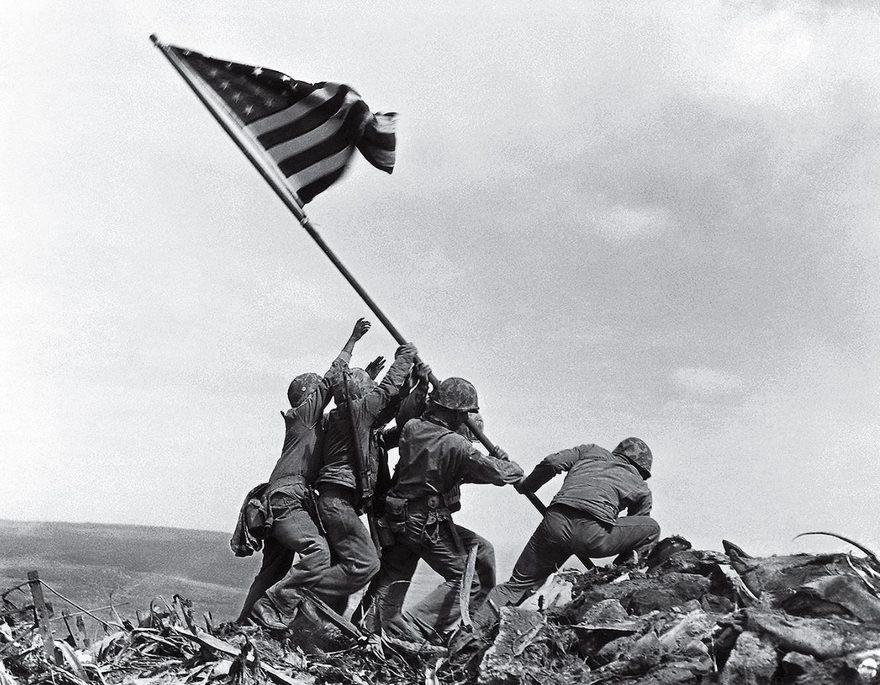 Flag Raising On Iwo Jima, Joe Rosenthal, 1945 It is but a speck of an island 760 miles south of Tokyo, a volcanic pile that blocked the Allies’ march toward Japan. The Americans needed Iwo Jima as an air base, but the Japanese had dug in. U.S. troops landed on February 19, 1945, beginning a month of fighting that claimed the lives of 6,800 Americans and 21,000 Japanese. On the fifth day of battle, the Marines captured Mount Suribachi. An American flag was quickly raised, but a commander called for a bigger one, in part to inspire his men and demoralize his opponents. Associated Press photographer Joe Rosenthal lugged his bulky Speed Graphic camera to the top, and as five Marines and a Navy corpsman prepared to hoist the Stars and Stripes, Rosenthal stepped back to get a better frame—and almost missed the shot. “The sky was overcast,” he later wrote of what has become one of the most recognizable images of war. “The wind just whipped the flag out over the heads of the group, and at their feet the disrupted terrain and the broken stalks of the shrubbery exemplified the turbulence of war.” Two days later Rosenthal’s photo was splashed on front pages across the U.S., where it was quickly embraced as a symbol of unity in the long-fought war. The picture, which earned Rosenthal a Pulitzer Prize, so resonated that it was made into a postage stamp and cast as a 100-ton bronze memorial.
Flag Raising On Iwo Jima, Joe Rosenthal, 1945 It is but a speck of an island 760 miles south of Tokyo, a volcanic pile that blocked the Allies’ march toward Japan. The Americans needed Iwo Jima as an air base, but the Japanese had dug in. U.S. troops landed on February 19, 1945, beginning a month of fighting that claimed the lives of 6,800 Americans and 21,000 Japanese. On the fifth day of battle, the Marines captured Mount Suribachi. An American flag was quickly raised, but a commander called for a bigger one, in part to inspire his men and demoralize his opponents. Associated Press photographer Joe Rosenthal lugged his bulky Speed Graphic camera to the top, and as five Marines and a Navy corpsman prepared to hoist the Stars and Stripes, Rosenthal stepped back to get a better frame—and almost missed the shot. “The sky was overcast,” he later wrote of what has become one of the most recognizable images of war. “The wind just whipped the flag out over the heads of the group, and at their feet the disrupted terrain and the broken stalks of the shrubbery exemplified the turbulence of war.” Two days later Rosenthal’s photo was splashed on front pages across the U.S., where it was quickly embraced as a symbol of unity in the long-fought war. The picture, which earned Rosenthal a Pulitzer Prize, so resonated that it was made into a postage stamp and cast as a 100-ton bronze memorial. -
17.
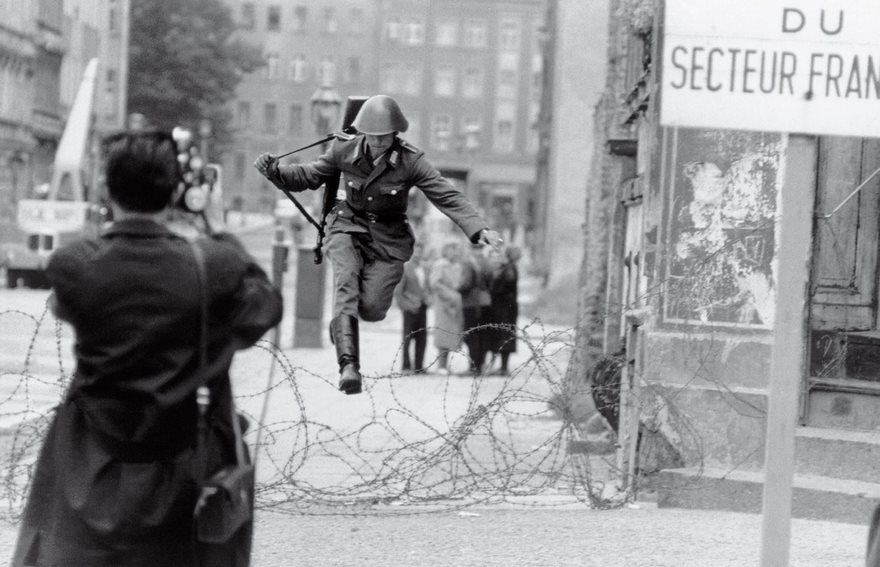 Leap Into Freedom, Peter Leibing, 1961 Following World War II, the conquering Allied governments carved Berlin into four occupation zones. Yet each part was not equal, and from 1949 to 1961 some 2.5 million East Germans fled the Soviet section in search of freedom. To stop the flow, East German leader Walter Ulbricht had a barbed-wire-and-cinder-block barrier thrown up in early August 1961. A few days later, Associated Press photographer Peter Leibing was tipped off that a defection might happen. He and other cameramen gathered and watched as a West Berlin crowd enticed 19-year-old border guard Hans Conrad Schumann, yelling to him, “Come on over!” Schumann, who later said he did not want to “live enclosed,” suddenly ran for the barricade. As he cleared the sharp wires he dropped his rifle and was whisked away. Sent out across the AP wire, Leibing’s photo ran on front pages across the world. It made Schumann, reportedly the first known East German soldier to flee, into a poster child for those yearning to be free, while lending urgency to East Germany’s push for a more permanent Berlin Wall. Schumann was sadly haunted by the weight of it all. While he quietly lived in the West, he could not grapple with his unintended stature as a symbol of freedom, and he committed suicide in 1998.
Leap Into Freedom, Peter Leibing, 1961 Following World War II, the conquering Allied governments carved Berlin into four occupation zones. Yet each part was not equal, and from 1949 to 1961 some 2.5 million East Germans fled the Soviet section in search of freedom. To stop the flow, East German leader Walter Ulbricht had a barbed-wire-and-cinder-block barrier thrown up in early August 1961. A few days later, Associated Press photographer Peter Leibing was tipped off that a defection might happen. He and other cameramen gathered and watched as a West Berlin crowd enticed 19-year-old border guard Hans Conrad Schumann, yelling to him, “Come on over!” Schumann, who later said he did not want to “live enclosed,” suddenly ran for the barricade. As he cleared the sharp wires he dropped his rifle and was whisked away. Sent out across the AP wire, Leibing’s photo ran on front pages across the world. It made Schumann, reportedly the first known East German soldier to flee, into a poster child for those yearning to be free, while lending urgency to East Germany’s push for a more permanent Berlin Wall. Schumann was sadly haunted by the weight of it all. While he quietly lived in the West, he could not grapple with his unintended stature as a symbol of freedom, and he committed suicide in 1998. -
18.
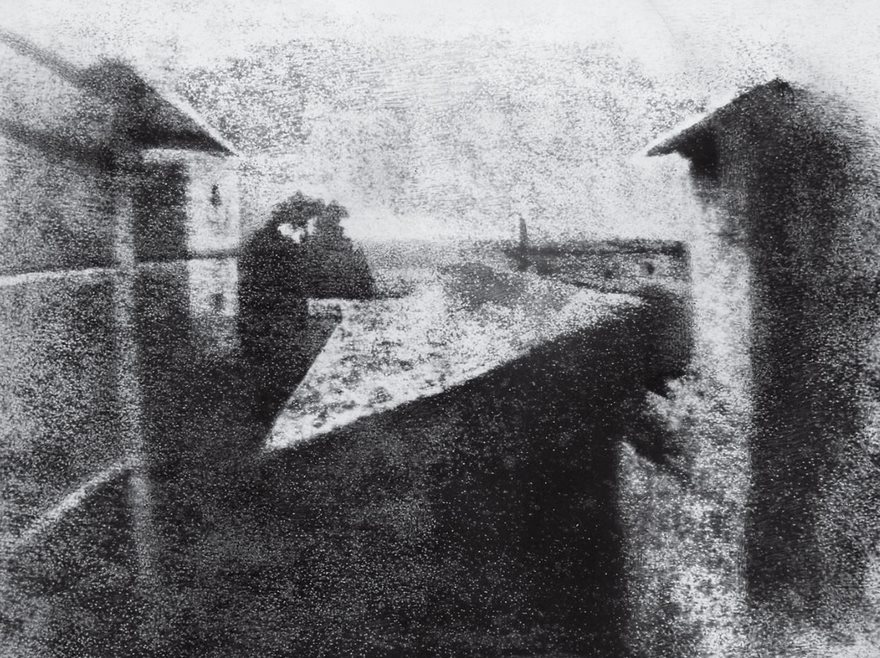 View From The Window At Le Gras, Joseph Nicéphore Niépce, 1826 It took a unique combination of ingenuity and curiosity to produce the first known photograph, so it’s fitting that the man who made it was an inventor and not an artist. In the 1820s, Joseph Nicéphore Niépce had become fascinated with the printing method of lithography, in which images drawn on stone could be reproduced using oil-based ink. Searching for other ways to produce images, Niépce set up a device called a camera obscura, which captured and projected scenes illuminated by sunlight, and trained it on the view outside his studio window in eastern France. The scene was cast on a treated pewter plate that, after many hours, retained a crude copy of the buildings and rooftops outside. The result was the first known permanent photograph. It is no overstatement to say that Niépce’s achievement laid the groundwork for the development of photography. Later, he worked with artist Louis Daguerre, whose sharper daguerreotype images marked photography’s next major advancement.
View From The Window At Le Gras, Joseph Nicéphore Niépce, 1826 It took a unique combination of ingenuity and curiosity to produce the first known photograph, so it’s fitting that the man who made it was an inventor and not an artist. In the 1820s, Joseph Nicéphore Niépce had become fascinated with the printing method of lithography, in which images drawn on stone could be reproduced using oil-based ink. Searching for other ways to produce images, Niépce set up a device called a camera obscura, which captured and projected scenes illuminated by sunlight, and trained it on the view outside his studio window in eastern France. The scene was cast on a treated pewter plate that, after many hours, retained a crude copy of the buildings and rooftops outside. The result was the first known permanent photograph. It is no overstatement to say that Niépce’s achievement laid the groundwork for the development of photography. Later, he worked with artist Louis Daguerre, whose sharper daguerreotype images marked photography’s next major advancement. -
19.
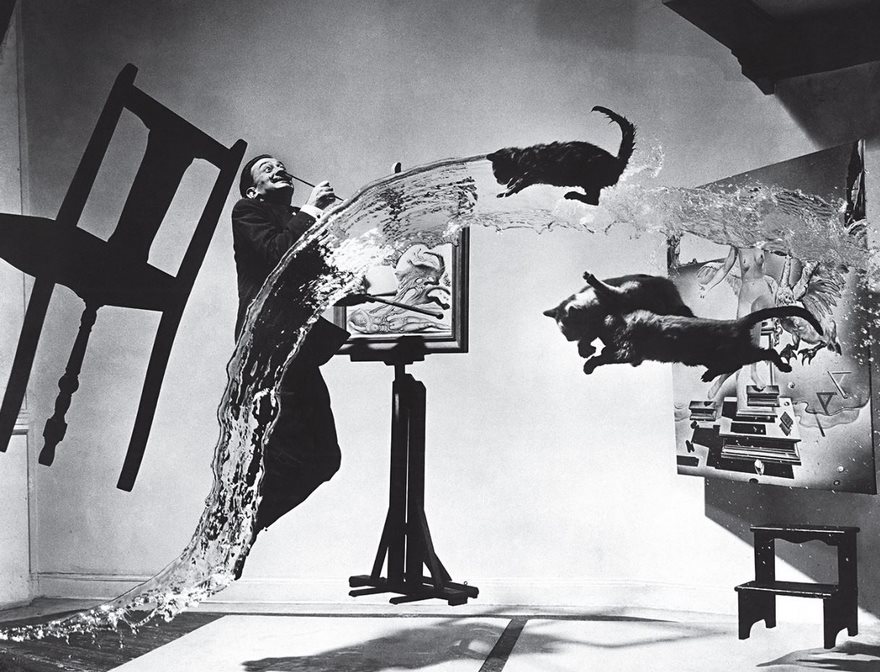 Dalí Atomicus, Philippe Halsman, 1948 Capturing the essence of those he photographed was Philippe Halsman’s life’s work. So when Halsman set out to shoot his friend and longtime collaborator the Surrealist painter Salvador Dalí, he knew a simple seated portrait would not suffice. Inspired by Dalí’s painting Leda Atomica, Halsman created an elaborate scene to surround the artist that included the original work, a floating chair and an in-progress easel suspended by thin wires. Assistants, including Halsman’s wife and young daughter Irene, stood out of the frame and, on the photographer’s count, threw three cats and a bucket of water into the air while Dalí leaped up. It took the assembled cast 26 takes to capture a composition that satisfied Halsman. And no wonder. The final result, published in LIFE, evokes Dalí’s own work. The artist even painted an image directly onto the print before publication. Before Halsman, portrait photography was often stilted and softly blurred, with a clear sense of detachment between the photographer and the subject. Halsman’s approach, to bring subjects such as Albert Einstein, Marilyn Monroe and Alfred Hitchcock into sharp focus as they moved before the camera, redefined portrait photography and inspired generations of photographers to collaborate with their subjects.
Dalí Atomicus, Philippe Halsman, 1948 Capturing the essence of those he photographed was Philippe Halsman’s life’s work. So when Halsman set out to shoot his friend and longtime collaborator the Surrealist painter Salvador Dalí, he knew a simple seated portrait would not suffice. Inspired by Dalí’s painting Leda Atomica, Halsman created an elaborate scene to surround the artist that included the original work, a floating chair and an in-progress easel suspended by thin wires. Assistants, including Halsman’s wife and young daughter Irene, stood out of the frame and, on the photographer’s count, threw three cats and a bucket of water into the air while Dalí leaped up. It took the assembled cast 26 takes to capture a composition that satisfied Halsman. And no wonder. The final result, published in LIFE, evokes Dalí’s own work. The artist even painted an image directly onto the print before publication. Before Halsman, portrait photography was often stilted and softly blurred, with a clear sense of detachment between the photographer and the subject. Halsman’s approach, to bring subjects such as Albert Einstein, Marilyn Monroe and Alfred Hitchcock into sharp focus as they moved before the camera, redefined portrait photography and inspired generations of photographers to collaborate with their subjects. -
20.
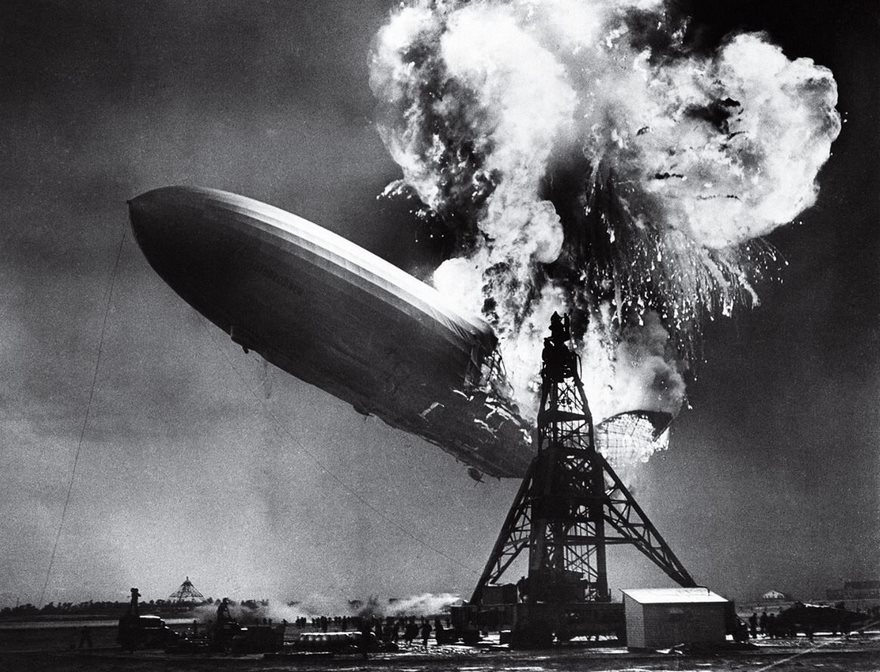 The Hindenburg Disaster, Sam Shere, 1937 Zeppelins were majestic skyliners, luxurious behemoths that signified wealth and power. The arrival of these ships was news, which is why Sam Shere of the International News Photos service was waiting in the rain at the Lakehurst, N.J., Naval Air Station on May 6, 1937, for the 804-foot-long LZ 129 Hindenburg to drift in from Frankfurt. Suddenly, as the assembled media watched, the grand ship’s flammable hydrogen caught fire, causing it to spectacularly burst into bright yellow flames and kill 36 people. Shere was one of nearly two dozen still and newsreel photographers who scrambled to document the fast-moving tragedy. But it is his image, with its stark immediacy and horrible grandeur, that has endured as the most famous—owing to its publication on front pages around the world and in LIFE and, more than three decades later, its use on the cover of the first Led Zeppelin album. The crash helped bring the age of the airships to a close, and Shere’s powerful photograph of one of the world’s most formative early air disasters persists as a cautionary reminder of how human fallibility can lead to death and destruction. Almost as famous as Shere’s photo is the anguished voice of Chicago radio announcer Herbert Morrison, who cried as he watched people tumbling through the air, “It is bursting into flames ... This is terrible. This is one of the worst catastrophes in the world ... Oh, the humanity!”
The Hindenburg Disaster, Sam Shere, 1937 Zeppelins were majestic skyliners, luxurious behemoths that signified wealth and power. The arrival of these ships was news, which is why Sam Shere of the International News Photos service was waiting in the rain at the Lakehurst, N.J., Naval Air Station on May 6, 1937, for the 804-foot-long LZ 129 Hindenburg to drift in from Frankfurt. Suddenly, as the assembled media watched, the grand ship’s flammable hydrogen caught fire, causing it to spectacularly burst into bright yellow flames and kill 36 people. Shere was one of nearly two dozen still and newsreel photographers who scrambled to document the fast-moving tragedy. But it is his image, with its stark immediacy and horrible grandeur, that has endured as the most famous—owing to its publication on front pages around the world and in LIFE and, more than three decades later, its use on the cover of the first Led Zeppelin album. The crash helped bring the age of the airships to a close, and Shere’s powerful photograph of one of the world’s most formative early air disasters persists as a cautionary reminder of how human fallibility can lead to death and destruction. Almost as famous as Shere’s photo is the anguished voice of Chicago radio announcer Herbert Morrison, who cried as he watched people tumbling through the air, “It is bursting into flames ... This is terrible. This is one of the worst catastrophes in the world ... Oh, the humanity!” -
21.
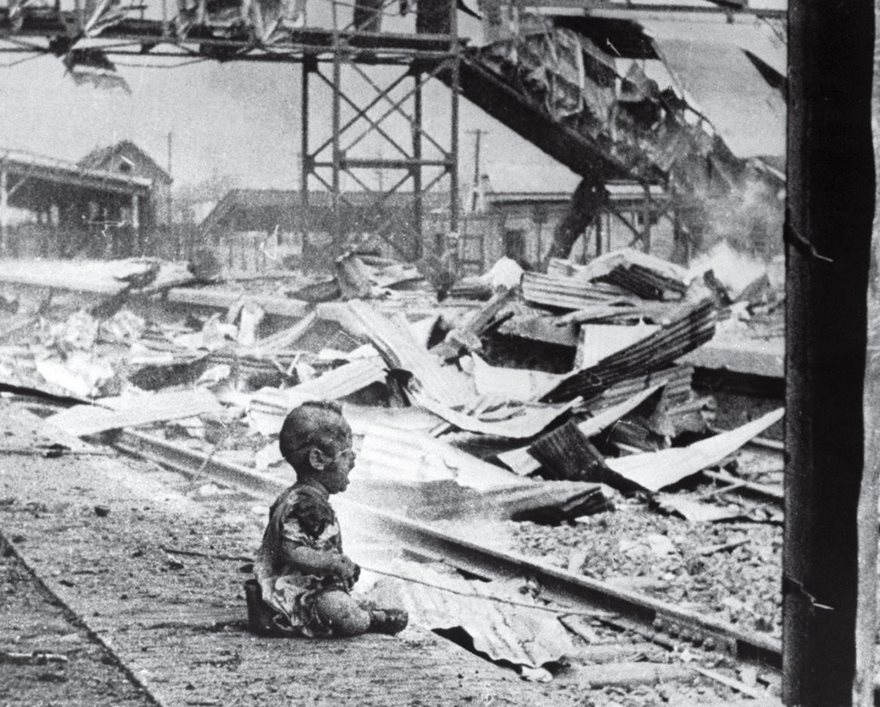 Bloody Saturday, H.s. Wong, 1937 The same imperialistic desires festering in Europe in the 1930s had already swept into Asia. Yet many Americans remained wary of wading into a conflict in what seemed a far-off, alien land. But that opinion began to change as Japan’s army of the Rising Sun rolled toward Shanghai in the summer of 1937. Fighting started there in August, and the unrelenting shelling and bombing caused mass panic and death in the streets. But the rest of the world didn’t put a face to the victims until they saw the aftermath of an August 28 attack by Japanese bombers. When H.S. Wong, a photographer for Hearst Metrotone News nicknamed Newsreel, arrived at the destroyed South Station, he recalled carnage so fresh “that my shoes were soaked with blood.” In the midst of the devastation, Wong saw a wailing Chinese baby whose mother lay dead on nearby tracks. He said he quickly shot his remaining film and then ran to carry the baby to safety, but not before the boy’s father raced over and ferried him away. Wong’s image of the wounded, helpless infant was sent to New York and featured in Hearst newsreels, newspapers and life magazine—the widest audience a picture could then have. Viewed by more than 136 million people, it struck a personal chord that transcended ethnicity and geography. To many, the infant’s pain represented the plight of China and the bloodlust of Japan, and the photo dubbed Bloody Saturday was transformed into one of the most powerful news pictures of all time. Its dissemination reveals the potent force of an image to sway official and public opinion. Wong’s picture led the U.S., Britain and France to formally protest the attack and helped shift Western sentiment in favor of wading into what would become the world’s second great war.
Bloody Saturday, H.s. Wong, 1937 The same imperialistic desires festering in Europe in the 1930s had already swept into Asia. Yet many Americans remained wary of wading into a conflict in what seemed a far-off, alien land. But that opinion began to change as Japan’s army of the Rising Sun rolled toward Shanghai in the summer of 1937. Fighting started there in August, and the unrelenting shelling and bombing caused mass panic and death in the streets. But the rest of the world didn’t put a face to the victims until they saw the aftermath of an August 28 attack by Japanese bombers. When H.S. Wong, a photographer for Hearst Metrotone News nicknamed Newsreel, arrived at the destroyed South Station, he recalled carnage so fresh “that my shoes were soaked with blood.” In the midst of the devastation, Wong saw a wailing Chinese baby whose mother lay dead on nearby tracks. He said he quickly shot his remaining film and then ran to carry the baby to safety, but not before the boy’s father raced over and ferried him away. Wong’s image of the wounded, helpless infant was sent to New York and featured in Hearst newsreels, newspapers and life magazine—the widest audience a picture could then have. Viewed by more than 136 million people, it struck a personal chord that transcended ethnicity and geography. To many, the infant’s pain represented the plight of China and the bloodlust of Japan, and the photo dubbed Bloody Saturday was transformed into one of the most powerful news pictures of all time. Its dissemination reveals the potent force of an image to sway official and public opinion. Wong’s picture led the U.S., Britain and France to formally protest the attack and helped shift Western sentiment in favor of wading into what would become the world’s second great war. -
22.
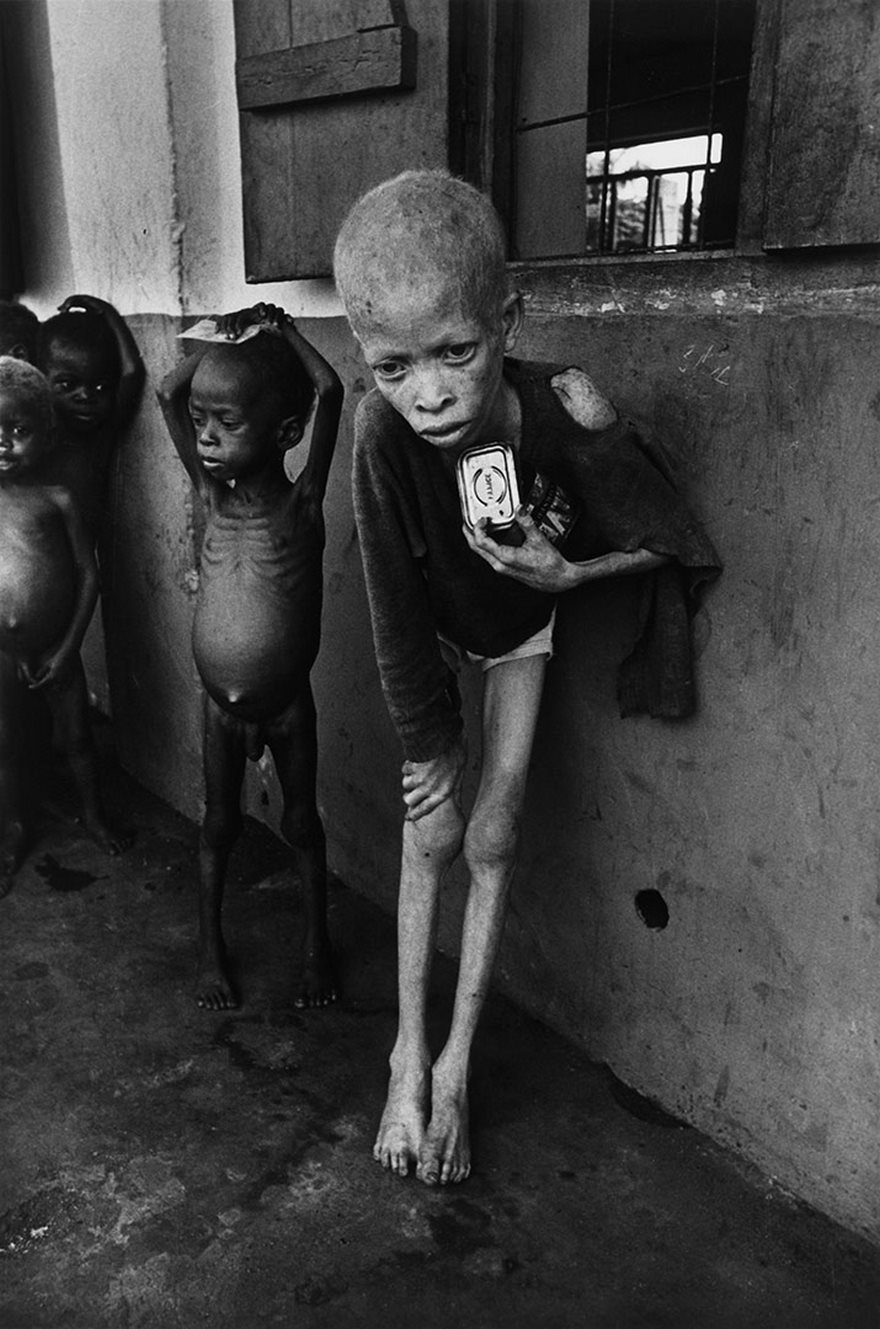 Albino Boy, Biafra, Don Mccullin, 1969 Few remember Biafra, the tiny western African nation that split off from southern Nigeria in 1967 and was retaken less than three years later. Much of the world learned of the enormity of that brief struggle through images of the mass starvation and disease that took the lives of possibly millions. None proved as powerful as British war photographer Don McCullin’s picture of a 9-year-old albino child. “To be a starving Biafran orphan was to be in a most pitiable situation, but to be a starving albino Biafran was to be in a position beyond description,” McCullin wrote. “Dying of starvation, he was still among his peers an object of ostracism, ridicule and insult.” This photo profoundly influenced public opinion, pressured governments to take action, and led to massive airlifts of food, medicine and weapons. McCullin hoped that such stark images would be able to “break the hearts and spirits of secure people.” While public attention eventually shifted, McCullin’s work left a lasting legacy: he and other witnesses of the conflict inspired the launch of Doctors Without Borders, which delivers emergency medical support to those suffering from war, epidemics and disasters.
Albino Boy, Biafra, Don Mccullin, 1969 Few remember Biafra, the tiny western African nation that split off from southern Nigeria in 1967 and was retaken less than three years later. Much of the world learned of the enormity of that brief struggle through images of the mass starvation and disease that took the lives of possibly millions. None proved as powerful as British war photographer Don McCullin’s picture of a 9-year-old albino child. “To be a starving Biafran orphan was to be in a most pitiable situation, but to be a starving albino Biafran was to be in a position beyond description,” McCullin wrote. “Dying of starvation, he was still among his peers an object of ostracism, ridicule and insult.” This photo profoundly influenced public opinion, pressured governments to take action, and led to massive airlifts of food, medicine and weapons. McCullin hoped that such stark images would be able to “break the hearts and spirits of secure people.” While public attention eventually shifted, McCullin’s work left a lasting legacy: he and other witnesses of the conflict inspired the launch of Doctors Without Borders, which delivers emergency medical support to those suffering from war, epidemics and disasters. -
23.
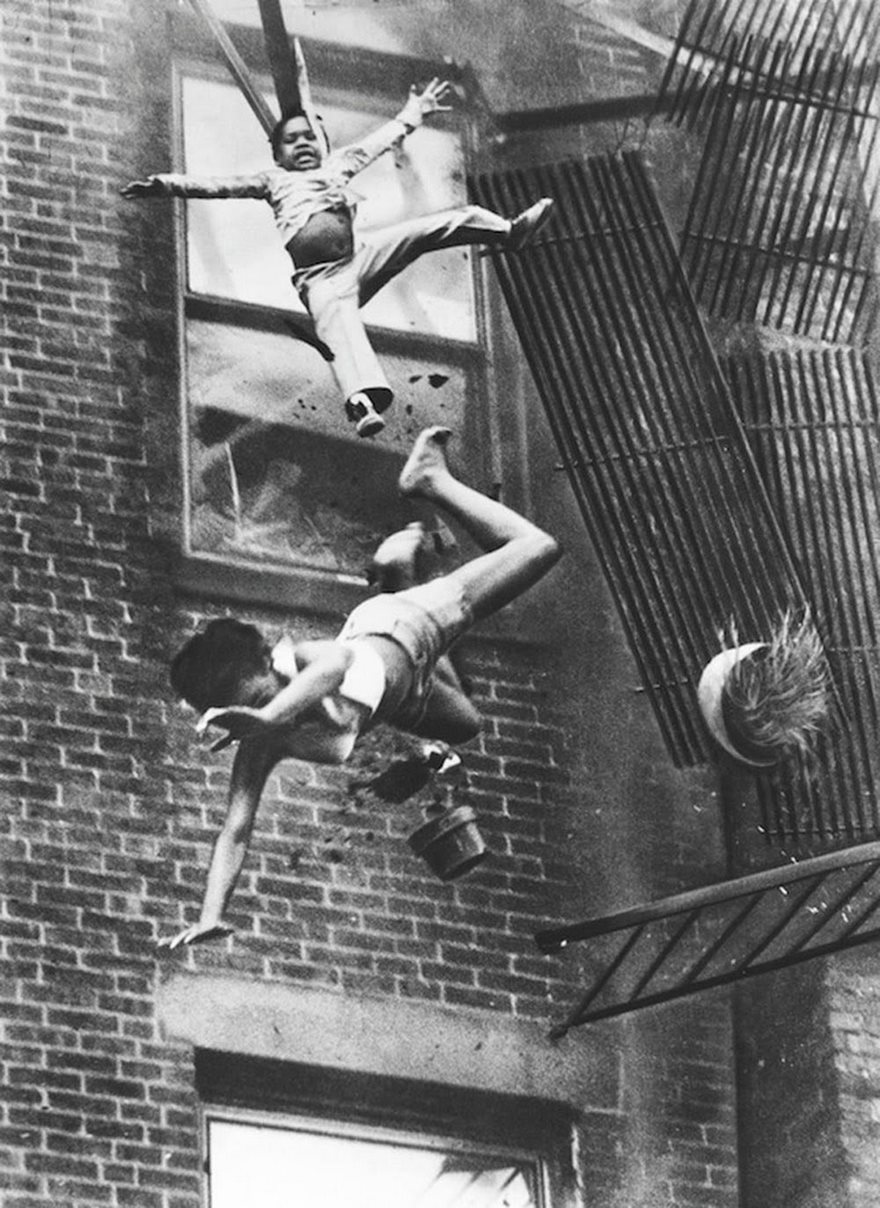 Fire Escape Collapse, Stanley Forman, 1975 Stanley Forman was working for the Boston Herald American on July 22, 1975, when he got a call about a fire on Marlborough Street. He raced over in time to see a woman and child on a fifth-floor fire escape. A fireman had set out to help them, and Forman figured he was shooting another routine rescue. “Suddenly the fire escape gave way,” he recalled, and Diana Bryant, 19, and her goddaughter Tiare Jones, 2, were swimming through the air. “I was shooting pictures as they were falling—then I turned away. It dawned on me what was happening, and I didn’t want to see them hit the ground. I can still remember turning around and shaking.” Bryant died from the fall, her body cushioning the blow for her goddaughter, who survived. While the event was no different from the routine tragedies that fill the local news, Forman’s picture of it was. Using a motor-drive camera, Forman was able to freeze the horrible tumbling moment down to the expression on young Tiare’s face. The photo earned Forman the Pulitzer Prize and led municipalities around the country to enact tougher fire-escape-safety codes. But its lasting legacy is as much ethical as temporal. Many readers objected to the publication of Forman’s picture, and it remains a case study in the debate over when disturbing images are worth sharing.
Fire Escape Collapse, Stanley Forman, 1975 Stanley Forman was working for the Boston Herald American on July 22, 1975, when he got a call about a fire on Marlborough Street. He raced over in time to see a woman and child on a fifth-floor fire escape. A fireman had set out to help them, and Forman figured he was shooting another routine rescue. “Suddenly the fire escape gave way,” he recalled, and Diana Bryant, 19, and her goddaughter Tiare Jones, 2, were swimming through the air. “I was shooting pictures as they were falling—then I turned away. It dawned on me what was happening, and I didn’t want to see them hit the ground. I can still remember turning around and shaking.” Bryant died from the fall, her body cushioning the blow for her goddaughter, who survived. While the event was no different from the routine tragedies that fill the local news, Forman’s picture of it was. Using a motor-drive camera, Forman was able to freeze the horrible tumbling moment down to the expression on young Tiare’s face. The photo earned Forman the Pulitzer Prize and led municipalities around the country to enact tougher fire-escape-safety codes. But its lasting legacy is as much ethical as temporal. Many readers objected to the publication of Forman’s picture, and it remains a case study in the debate over when disturbing images are worth sharing. -
24.
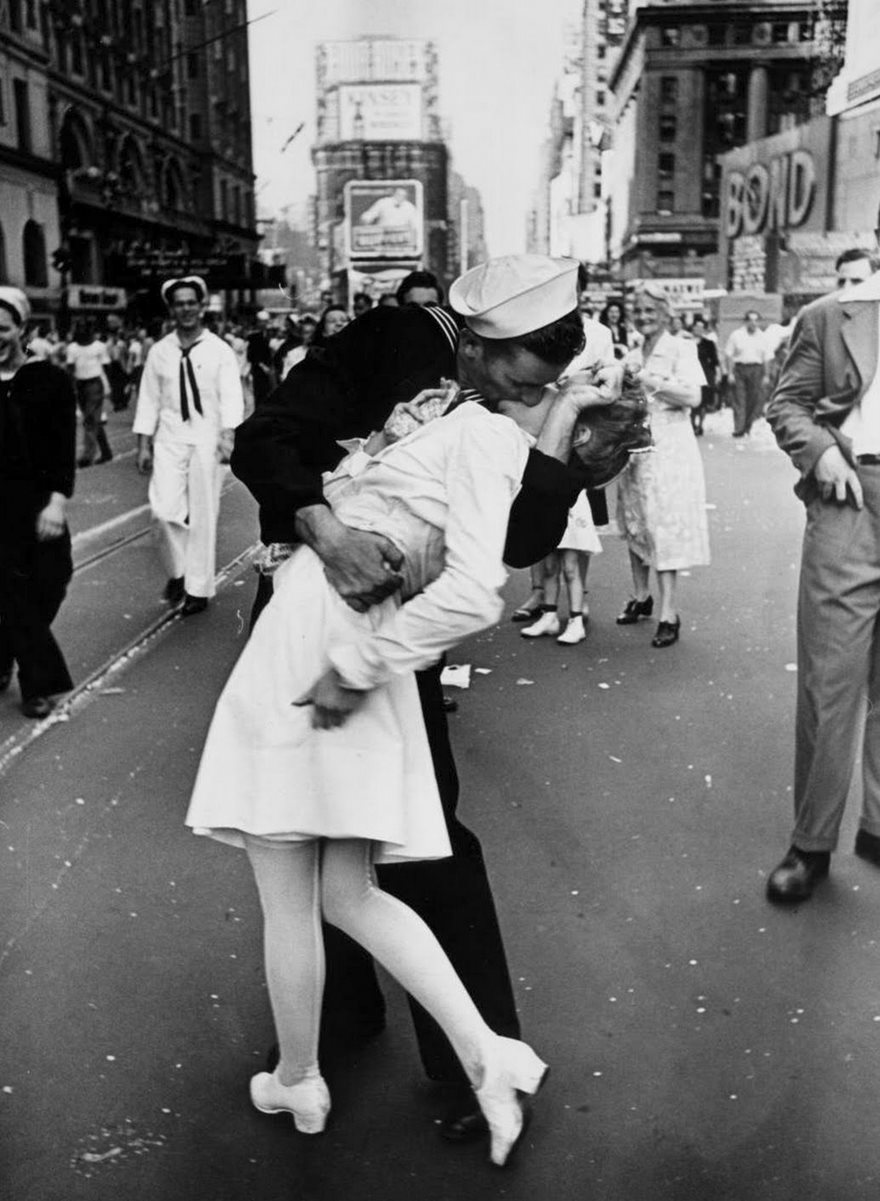 V-J Day In Times Square, Alfred Eisenstaedt, 1945 At its best, photography captures fleeting snippets that crystallize the hope, anguish, wonder and joy of life. Alfred Eisenstaedt, one of the first four photographers hired by LIFE magazine, made it his mission “to find and catch the storytelling moment.” He didn’t have to go far for it when World War II ended on August 14, 1945. Taking in the mood on the streets of New York City, Eisenstaedt soon found himself in the joyous tumult of Times Square. As he searched for subjects, a sailor in front of him grabbed hold of a nurse, tilted her back and kissed her. Eisenstaedt’s photograph of that passionate swoop distilled the relief and promise of that momentous day in a single moment of unbridled joy (although some argue today that it should be seen as a case of sexual assault). His beautiful image has become the most famous and frequently reproduced picture of the 20th century, and it forms the basis of our collective memory of that transformative moment in world history. “People tell me that when I’m in heaven,” Eisenstaedt said, “they will remember this picture.”
V-J Day In Times Square, Alfred Eisenstaedt, 1945 At its best, photography captures fleeting snippets that crystallize the hope, anguish, wonder and joy of life. Alfred Eisenstaedt, one of the first four photographers hired by LIFE magazine, made it his mission “to find and catch the storytelling moment.” He didn’t have to go far for it when World War II ended on August 14, 1945. Taking in the mood on the streets of New York City, Eisenstaedt soon found himself in the joyous tumult of Times Square. As he searched for subjects, a sailor in front of him grabbed hold of a nurse, tilted her back and kissed her. Eisenstaedt’s photograph of that passionate swoop distilled the relief and promise of that momentous day in a single moment of unbridled joy (although some argue today that it should be seen as a case of sexual assault). His beautiful image has become the most famous and frequently reproduced picture of the 20th century, and it forms the basis of our collective memory of that transformative moment in world history. “People tell me that when I’m in heaven,” Eisenstaedt said, “they will remember this picture.” -
25.
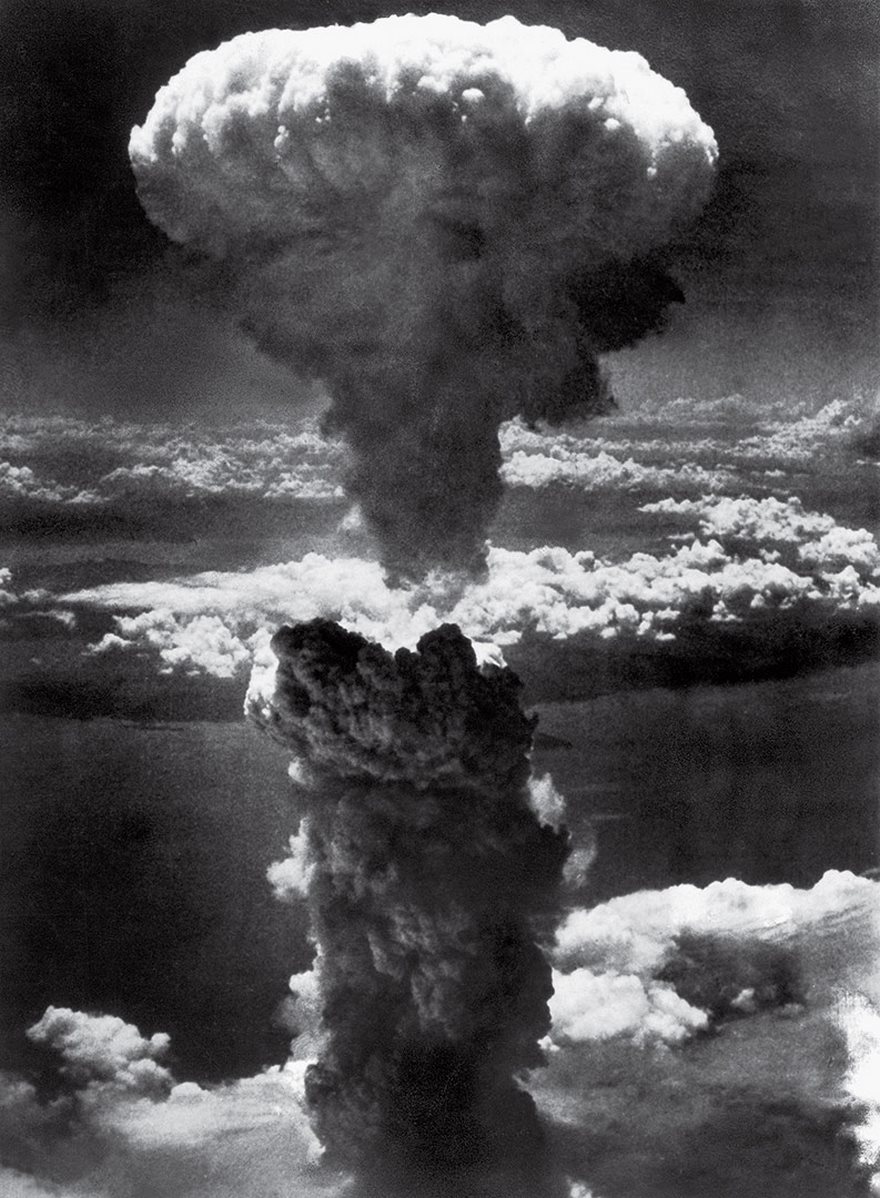 Mushroom Cloud Over Nagasaki, Lieutenant Charles Levy, 1945 Three days after an atomic bomb nicknamed Little Boy obliterated Hiroshima, Japan, U.S. forces dropped an even more powerful weapon dubbed Fat Man on Nagasaki. The explosion shot up a 45,000-foot-high column of radioactive dust and debris. “We saw this big plume climbing up, up into the sky,” recalled Lieutenant Charles Levy, the bombardier, who was knocked over by the blow from the 20-kiloton weapon. “It was purple, red, white, all colors—something like boiling coffee. It looked alive.” The officer then shot 16 photographs of the new weapon’s awful power as it yanked the life out of some 80,000 people in the city on the Urakami River. Six days later, the two bombs forced Emperor Hirohito to announce Japan’s unconditional surrender in World War II. Officials censored photos of the bomb’s devastation, but Levy’s image—the only one to show the full scale of the mushroom cloud from the air—was circulated widely. The effect shaped American opinion in favor of the nuclear bomb, leading the nation to celebrate the atomic age and proving, yet again, that history is written by the victors.
Mushroom Cloud Over Nagasaki, Lieutenant Charles Levy, 1945 Three days after an atomic bomb nicknamed Little Boy obliterated Hiroshima, Japan, U.S. forces dropped an even more powerful weapon dubbed Fat Man on Nagasaki. The explosion shot up a 45,000-foot-high column of radioactive dust and debris. “We saw this big plume climbing up, up into the sky,” recalled Lieutenant Charles Levy, the bombardier, who was knocked over by the blow from the 20-kiloton weapon. “It was purple, red, white, all colors—something like boiling coffee. It looked alive.” The officer then shot 16 photographs of the new weapon’s awful power as it yanked the life out of some 80,000 people in the city on the Urakami River. Six days later, the two bombs forced Emperor Hirohito to announce Japan’s unconditional surrender in World War II. Officials censored photos of the bomb’s devastation, but Levy’s image—the only one to show the full scale of the mushroom cloud from the air—was circulated widely. The effect shaped American opinion in favor of the nuclear bomb, leading the nation to celebrate the atomic age and proving, yet again, that history is written by the victors. -
26.
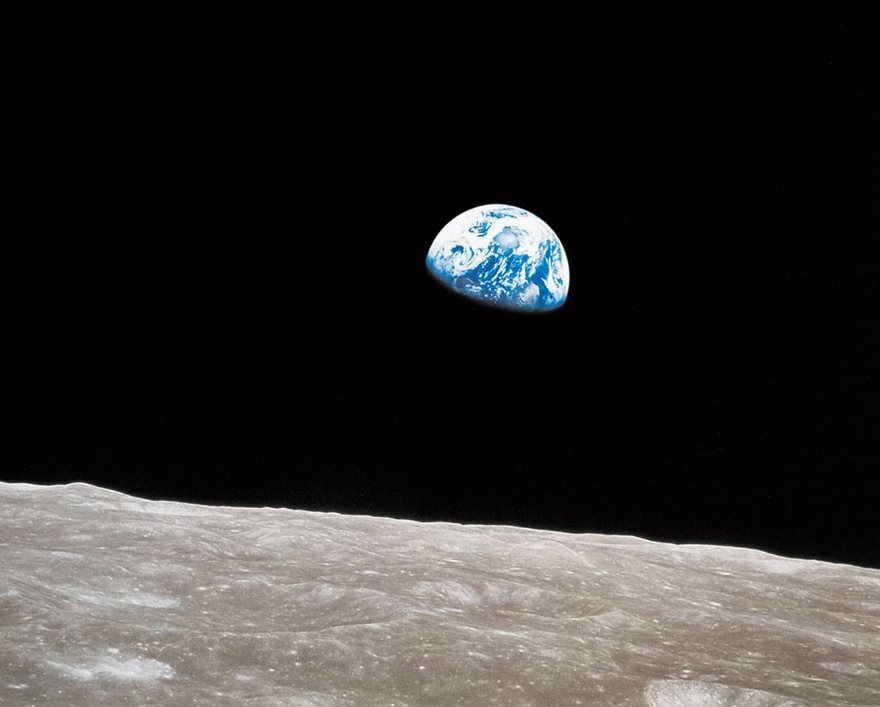 Earthrise, William Anders, NASA, 1968 It’s never easy to identify the moment a hinge turns in history. When it comes to humanity’s first true grasp of the beauty, fragility and loneliness of our world, however, we know the precise instant. It was on December 24, 1968, exactly 75 hours, 48 minutes and 41 seconds after the Apollo 8 spacecraft lifted off from Cape Canaveral en route to becoming the first manned mission to orbit the moon. Astronauts Frank Borman, Jim Lovell and Bill Anders entered lunar orbit on Christmas Eve of what had been a bloody, war-torn year for America. At the beginning of the fourth of 10 orbits, their spacecraft was emerging from the far side of the moon when a view of the blue-white planet filled one of the hatch windows. “Oh, my God! Look at that picture over there! Here’s the Earth coming up. Wow, is that pretty!” Anders exclaimed. He snapped a picture—in black and white. Lovell scrambled to find a color canister. “Well, I think we missed it,” Anders said. Lovell looked through windows three and four. “Hey, I got it right here!” he exclaimed. A weightless Anders shot to where Lovell was floating and fired his Hasselblad. “You got it?” Lovell asked. “Yep,” Anders answered. The image—our first full-color view of our planet from off of it—helped to launch the environmental movement. And, just as important, it helped human beings recognize that in a cold and punishing cosmos, we’ve got it pretty good.
Earthrise, William Anders, NASA, 1968 It’s never easy to identify the moment a hinge turns in history. When it comes to humanity’s first true grasp of the beauty, fragility and loneliness of our world, however, we know the precise instant. It was on December 24, 1968, exactly 75 hours, 48 minutes and 41 seconds after the Apollo 8 spacecraft lifted off from Cape Canaveral en route to becoming the first manned mission to orbit the moon. Astronauts Frank Borman, Jim Lovell and Bill Anders entered lunar orbit on Christmas Eve of what had been a bloody, war-torn year for America. At the beginning of the fourth of 10 orbits, their spacecraft was emerging from the far side of the moon when a view of the blue-white planet filled one of the hatch windows. “Oh, my God! Look at that picture over there! Here’s the Earth coming up. Wow, is that pretty!” Anders exclaimed. He snapped a picture—in black and white. Lovell scrambled to find a color canister. “Well, I think we missed it,” Anders said. Lovell looked through windows three and four. “Hey, I got it right here!” he exclaimed. A weightless Anders shot to where Lovell was floating and fired his Hasselblad. “You got it?” Lovell asked. “Yep,” Anders answered. The image—our first full-color view of our planet from off of it—helped to launch the environmental movement. And, just as important, it helped human beings recognize that in a cold and punishing cosmos, we’ve got it pretty good. -
27.
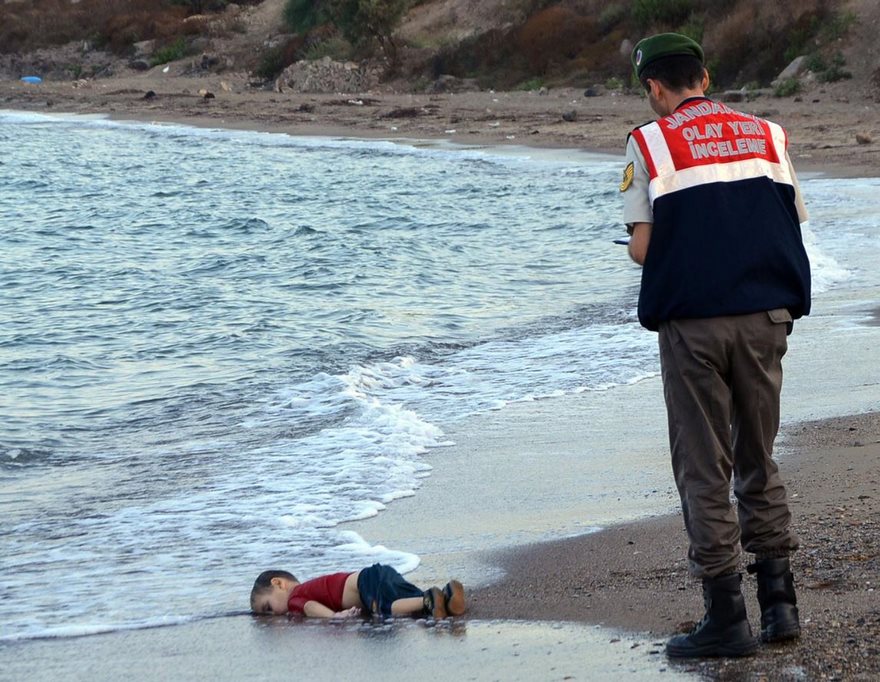 Alan Kurdi, Nilüfer Demir, 2015 The war in Syria had been going on for more than four years when Alan Kurdi’s parents lifted the 3-year-old boy and his 5-year-old brother into an inflatable boat and set off from the Turkish coast for the Greek island of Kos, just three miles away. Within minutes of pushing off, a wave capsized the vessel, and the mother and both sons drowned. On the shore near the coastal town of Bodrum a few hours later, Nilufer Demir of the Dogan News Agency, came upon Alan, his face turned to one side and bottom elevated as if he were just asleep. “There was nothing left to do for him. There was nothing left to bring him back to life,” she said. So Demir raised her camera. "I thought, This is the only way I can express the scream of his silent body." The resulting image became the defining photograph of an ongoing war that, by the time Demir pressed her shutter, had killed some 220,000 people. It was taken not in Syria, a country the world preferred to ignore, but on the doorstep of Europe, where its refugees were heading. Dressed for travel, the child lay between one world and another: waves had washed away any chalky brown dust that might locate him in a place foreign to Westerners’ experience. It was an experience the Kurdis sought for themselves, joining a migration fueled as much by aspiration as desperation. The family had already escaped bloodshed by making it across the land border to Turkey; the sea journey was in search of a better life, one that would now become — at least for a few months — far more accessible for the hundreds of thousands traveling behind them. Demir’s image whipped around social media within hours, accumulating potency with every share. News organizations were compelled to publish it—or publicly defend their decision not to. And European governments were suddenly compelled to open closed frontiers. Within a week, trainloads of Syrians were arriving in Germany to cheers, as a war lamented but not felt suddenly brimmed with emotions unlocked by a picture of one small, still form.
Alan Kurdi, Nilüfer Demir, 2015 The war in Syria had been going on for more than four years when Alan Kurdi’s parents lifted the 3-year-old boy and his 5-year-old brother into an inflatable boat and set off from the Turkish coast for the Greek island of Kos, just three miles away. Within minutes of pushing off, a wave capsized the vessel, and the mother and both sons drowned. On the shore near the coastal town of Bodrum a few hours later, Nilufer Demir of the Dogan News Agency, came upon Alan, his face turned to one side and bottom elevated as if he were just asleep. “There was nothing left to do for him. There was nothing left to bring him back to life,” she said. So Demir raised her camera. "I thought, This is the only way I can express the scream of his silent body." The resulting image became the defining photograph of an ongoing war that, by the time Demir pressed her shutter, had killed some 220,000 people. It was taken not in Syria, a country the world preferred to ignore, but on the doorstep of Europe, where its refugees were heading. Dressed for travel, the child lay between one world and another: waves had washed away any chalky brown dust that might locate him in a place foreign to Westerners’ experience. It was an experience the Kurdis sought for themselves, joining a migration fueled as much by aspiration as desperation. The family had already escaped bloodshed by making it across the land border to Turkey; the sea journey was in search of a better life, one that would now become — at least for a few months — far more accessible for the hundreds of thousands traveling behind them. Demir’s image whipped around social media within hours, accumulating potency with every share. News organizations were compelled to publish it—or publicly defend their decision not to. And European governments were suddenly compelled to open closed frontiers. Within a week, trainloads of Syrians were arriving in Germany to cheers, as a war lamented but not felt suddenly brimmed with emotions unlocked by a picture of one small, still form. -
28.
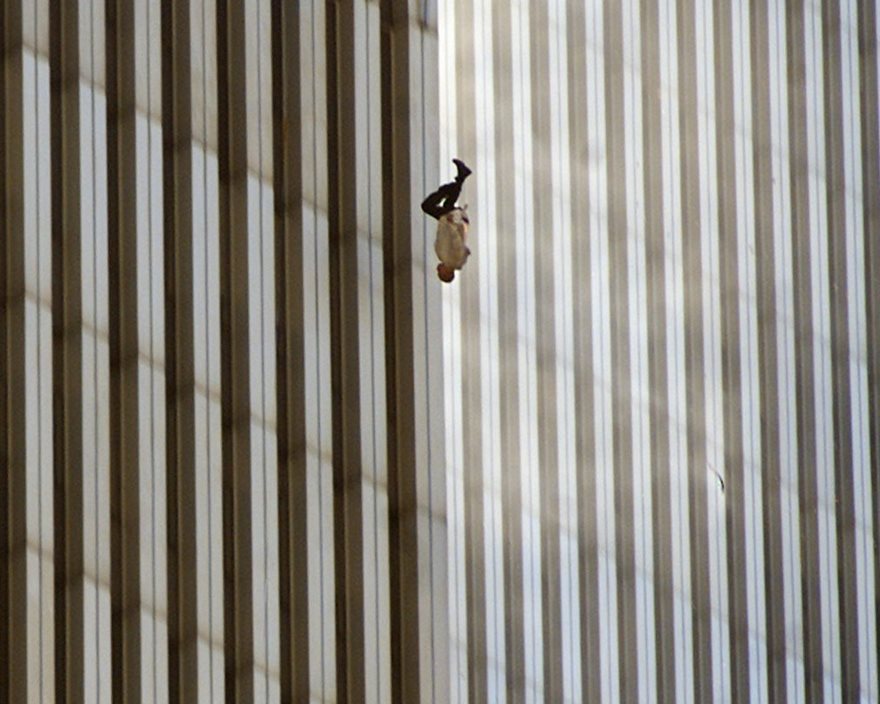 Falling Man, Richard Drew, 2001 The most widely seen images from 9/11 are of planes and towers, not people. Falling Man is different. The photo, taken by Richard Drew in the moments after the September 11, 2001, attacks, is one man’s distinct escape from the collapsing buildings, a symbol of individuality against the backdrop of faceless skyscrapers. On a day of mass tragedy, Falling Man is one of the only widely seen pictures that shows someone dying. The photo was published in newspapers around the U.S. in the days after the attacks, but backlash from readers forced it into temporary obscurity. It can be a difficult image to process, the man perfectly bisecting the iconic towers as he darts toward the earth like an arrow. Falling Man’s identity is still unknown, but he is believed to have been an employee at the Windows on the World restaurant, which sat atop the north tower. The true power of Falling Man, however, is less about who its subject was and more about what he became: a makeshift Unknown Soldier in an often unknown and uncertain war, suspended forever in history.
Falling Man, Richard Drew, 2001 The most widely seen images from 9/11 are of planes and towers, not people. Falling Man is different. The photo, taken by Richard Drew in the moments after the September 11, 2001, attacks, is one man’s distinct escape from the collapsing buildings, a symbol of individuality against the backdrop of faceless skyscrapers. On a day of mass tragedy, Falling Man is one of the only widely seen pictures that shows someone dying. The photo was published in newspapers around the U.S. in the days after the attacks, but backlash from readers forced it into temporary obscurity. It can be a difficult image to process, the man perfectly bisecting the iconic towers as he darts toward the earth like an arrow. Falling Man’s identity is still unknown, but he is believed to have been an employee at the Windows on the World restaurant, which sat atop the north tower. The true power of Falling Man, however, is less about who its subject was and more about what he became: a makeshift Unknown Soldier in an often unknown and uncertain war, suspended forever in history. -
29.
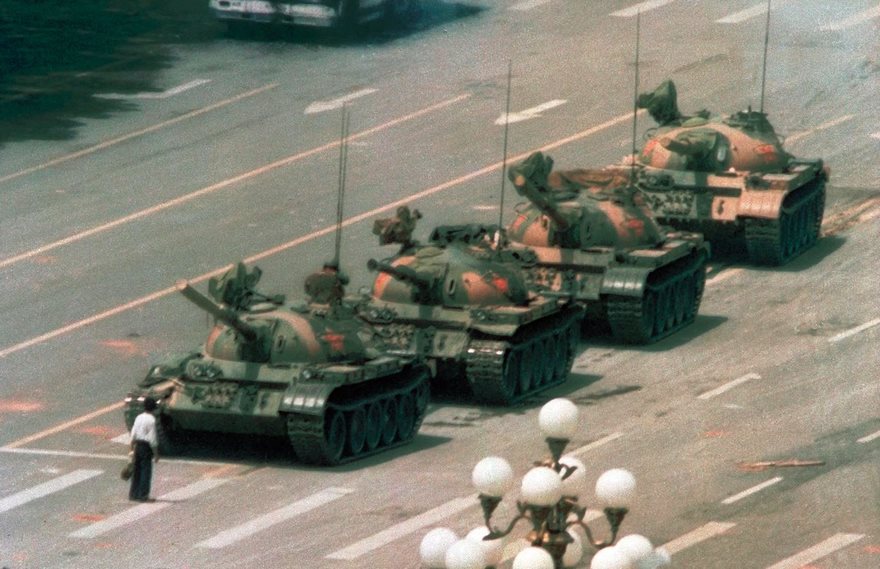 Tank Man, Jeff Widener, 1989 On the morning of June 5, 1989, photographer Jeff Widener was perched on a sixth-floor balcony of the Beijing Hotel. It was a day after the Tiananmen Square massacre, when Chinese troops attacked pro-democracy demonstrators camped on the plaza, and the Associated Press sent Widener to document the aftermath. As he photographed bloody victims, passersby on bicycles and the occasional scorched bus, a column of tanks began rolling out of the plaza. Widener lined up his lens just as a man carrying shopping bags stepped in front of the war machines, waving his arms and refusing to move. The tanks tried to go around the man, but he stepped back into their path, climbing atop one briefly. Widener assumed the man would be killed, but the tanks held their fire. Eventually the man was whisked away, but not before Widener immortalized his singular act of resistance. Others also captured the scene, but Widener’s image was transmitted over the AP wire and appeared on front pages all over the world. Decades after Tank Man became a global hero, he remains unidentified. The anonymity makes the photograph all the more universal, a symbol of resistance to unjust regimes everywhere.
Tank Man, Jeff Widener, 1989 On the morning of June 5, 1989, photographer Jeff Widener was perched on a sixth-floor balcony of the Beijing Hotel. It was a day after the Tiananmen Square massacre, when Chinese troops attacked pro-democracy demonstrators camped on the plaza, and the Associated Press sent Widener to document the aftermath. As he photographed bloody victims, passersby on bicycles and the occasional scorched bus, a column of tanks began rolling out of the plaza. Widener lined up his lens just as a man carrying shopping bags stepped in front of the war machines, waving his arms and refusing to move. The tanks tried to go around the man, but he stepped back into their path, climbing atop one briefly. Widener assumed the man would be killed, but the tanks held their fire. Eventually the man was whisked away, but not before Widener immortalized his singular act of resistance. Others also captured the scene, but Widener’s image was transmitted over the AP wire and appeared on front pages all over the world. Decades after Tank Man became a global hero, he remains unidentified. The anonymity makes the photograph all the more universal, a symbol of resistance to unjust regimes everywhere. -
30.
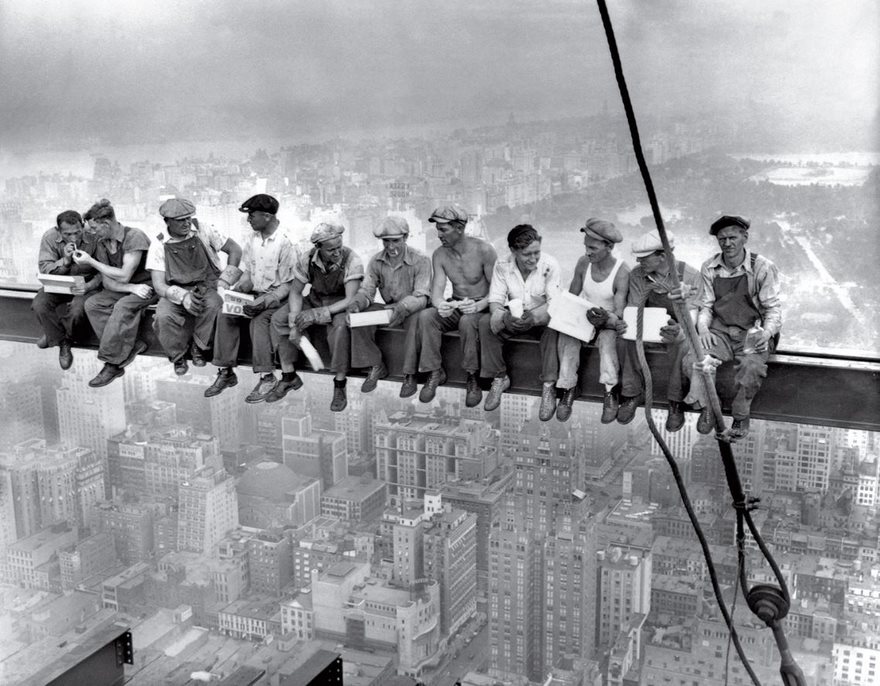 Lunch Atop A Skyscraper, 1932 It’s the most perilous yet playful lunch break ever captured: 11 men casually eating, chatting and sneaking a smoke as if they weren’t 840 feet above Manhattan with nothing but a thin beam keeping them aloft. That comfort is real; the men are among the construction workers who helped build Rockefeller Center. But the picture, taken on the 69th floor of the flagship RCA Building (now the GE Building), was staged as part of a promotional campaign for the massive skyscraper complex. While the photographer and the identities of most of the subjects remain a mystery—the photographers Charles C. Ebbets, Thomas Kelley and William Leftwich were all present that day, and it’s not known which one took it—there isn’t an ironworker in New York City who doesn’t see the picture as a badge of their bold tribe. In that way they are not alone. By thumbing its nose at both danger and the Depression, Lunch Atop a Skyscraper came to symbolize American resilience and ambition at a time when both were desperately needed. It has since become an iconic emblem of the city in which it was taken, affirming the romantic belief that New York is a place unafraid to tackle projects that would cow less brazen cities. And like all symbols in a city built on hustle, Lunch Atop a Skyscraper has spawned its own economy. It is the Corbis photo agency’s most reproduced image. And good luck walking through Times Square without someone hawking it on a mug, magnet or T-shirt.
Lunch Atop A Skyscraper, 1932 It’s the most perilous yet playful lunch break ever captured: 11 men casually eating, chatting and sneaking a smoke as if they weren’t 840 feet above Manhattan with nothing but a thin beam keeping them aloft. That comfort is real; the men are among the construction workers who helped build Rockefeller Center. But the picture, taken on the 69th floor of the flagship RCA Building (now the GE Building), was staged as part of a promotional campaign for the massive skyscraper complex. While the photographer and the identities of most of the subjects remain a mystery—the photographers Charles C. Ebbets, Thomas Kelley and William Leftwich were all present that day, and it’s not known which one took it—there isn’t an ironworker in New York City who doesn’t see the picture as a badge of their bold tribe. In that way they are not alone. By thumbing its nose at both danger and the Depression, Lunch Atop a Skyscraper came to symbolize American resilience and ambition at a time when both were desperately needed. It has since become an iconic emblem of the city in which it was taken, affirming the romantic belief that New York is a place unafraid to tackle projects that would cow less brazen cities. And like all symbols in a city built on hustle, Lunch Atop a Skyscraper has spawned its own economy. It is the Corbis photo agency’s most reproduced image. And good luck walking through Times Square without someone hawking it on a mug, magnet or T-shirt. -
31.
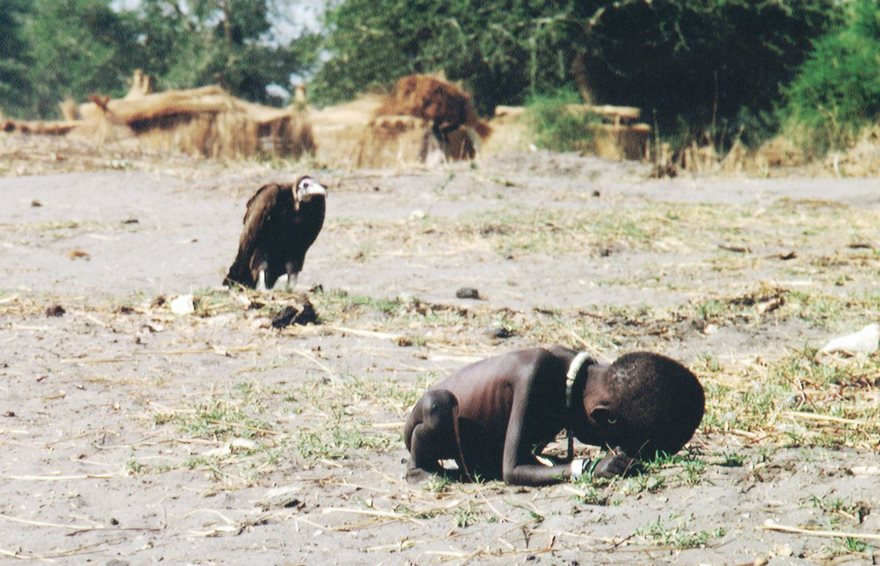 Starving Child And Vulture, Kevin Carter, 1993 Kevin Carter knew the stench of death. As a member of the Bang-Bang Club, a quartet of brave photographers who chronicled apartheid-era South Africa, he had seen more than his share of heartbreak. In 1993 he flew to Sudan to photograph the famine racking that land. Exhausted after a day of taking pictures in the village of Ayod, he headed out into the open bush. There he heard whimpering and came across an emaciated toddler who had collapsed on the way to a feeding center. As he took the child’s picture, a plump vulture landed nearby. Carter had reportedly been advised not to touch the victims because of disease, so instead of helping, he spent 20 minutes waiting in the hope that the stalking bird would open its wings. It did not. Carter scared the creature away and watched as the child continued toward the center. He then lit a cigarette, talked to God and wept. The New York Times ran the photo, and readers were eager to find out what happened to the child—and to criticize Carter for not coming to his subject’s aid. His image quickly became a wrenching case study in the debate over when photographers should intervene. Subsequent research seemed to reveal that the child did survive yet died 14 years later from malarial fever. Carter won a Pulitzer for his image, but the darkness of that bright day never lifted from him. In July 1994 he took his own life, writing, “I am haunted by the vivid memories of killings & corpses & anger & pain.”
Starving Child And Vulture, Kevin Carter, 1993 Kevin Carter knew the stench of death. As a member of the Bang-Bang Club, a quartet of brave photographers who chronicled apartheid-era South Africa, he had seen more than his share of heartbreak. In 1993 he flew to Sudan to photograph the famine racking that land. Exhausted after a day of taking pictures in the village of Ayod, he headed out into the open bush. There he heard whimpering and came across an emaciated toddler who had collapsed on the way to a feeding center. As he took the child’s picture, a plump vulture landed nearby. Carter had reportedly been advised not to touch the victims because of disease, so instead of helping, he spent 20 minutes waiting in the hope that the stalking bird would open its wings. It did not. Carter scared the creature away and watched as the child continued toward the center. He then lit a cigarette, talked to God and wept. The New York Times ran the photo, and readers were eager to find out what happened to the child—and to criticize Carter for not coming to his subject’s aid. His image quickly became a wrenching case study in the debate over when photographers should intervene. Subsequent research seemed to reveal that the child did survive yet died 14 years later from malarial fever. Carter won a Pulitzer for his image, but the darkness of that bright day never lifted from him. In July 1994 he took his own life, writing, “I am haunted by the vivid memories of killings & corpses & anger & pain.” -
32.
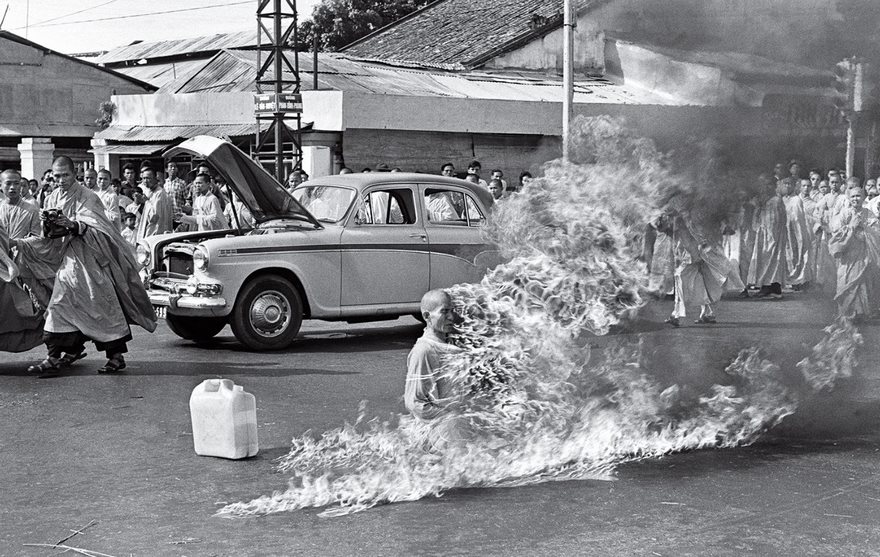 The Burning Monk, Malcolm Browne, 1963 In June 1963, most Americans couldn’t find Vietnam on a map. But there was no forgetting that war-torn Southeast Asian nation after Associated Press photographer Malcolm Browne captured the image of Thich Quang Duc immolating himself on a Saigon street. Browne had been given a heads-up that something was going to happen to protest the treatment of Buddhists by the regime of President Ngo Dinh Diem. Once there he watched as two monks doused the seated elderly man with gasoline. “I realized at that moment exactly what was happening, and began to take pictures a few seconds apart,” he wrote soon after. His Pulitzer Prize–winning photo of the seemingly serene monk sitting lotus style as he is enveloped in flames became the first iconic image to emerge from a q5uagmire that would soon pull in America. Quang Duc’s act of martyrdom became a sign of the volatility of his nation, and President Kennedy later commented, “No news picture in history has generated so much emotion around the world as that one.” Browne’s photo forced people to question the U.S.’s association with Diem’s government, and soon resulted in the Administration’s decision not to interfere with a coup that November.
The Burning Monk, Malcolm Browne, 1963 In June 1963, most Americans couldn’t find Vietnam on a map. But there was no forgetting that war-torn Southeast Asian nation after Associated Press photographer Malcolm Browne captured the image of Thich Quang Duc immolating himself on a Saigon street. Browne had been given a heads-up that something was going to happen to protest the treatment of Buddhists by the regime of President Ngo Dinh Diem. Once there he watched as two monks doused the seated elderly man with gasoline. “I realized at that moment exactly what was happening, and began to take pictures a few seconds apart,” he wrote soon after. His Pulitzer Prize–winning photo of the seemingly serene monk sitting lotus style as he is enveloped in flames became the first iconic image to emerge from a q5uagmire that would soon pull in America. Quang Duc’s act of martyrdom became a sign of the volatility of his nation, and President Kennedy later commented, “No news picture in history has generated so much emotion around the world as that one.” Browne’s photo forced people to question the U.S.’s association with Diem’s government, and soon resulted in the Administration’s decision not to interfere with a coup that November.
- REPLAY GALLERY
-
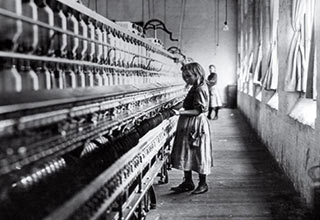
- 30 Amazing And Disturbing Photos From History's Vaults
- NEXT GALLERY
-
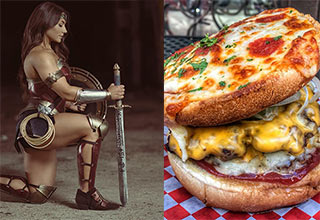
- 43 Badass Pics To Wrap Up Your Weekend
Nuit De Noel, Malick Sidibe, 1963 Malian photographer Malick Sidibé’s life followed the trajectory of his nation. He started out herding his family’s goats, then trained in jewelry making, painting and photography. As French colonial rule ended in 1960, he captured the subtle and profound changes reshaping his nation. Nicknamed the Eye of Bamako, Sidibé took thousands of photos that became a real-time chronicle of the euphoric zeitgeist gripping the capital, a document of a fleeting moment. “Everyone had to have the latest Paris style,” he observed of young people wearing flashy clothes, straddling Vespas and nuzzling in public as they embraced a world without shackles. On Christmas Eve in 1963, Sidibé happened on a young couple at a club, lost in each other’s eyes. What Sidibé called his “talent to observe” allowed him to capture their quiet intimacy, heads brushing as they grace an empty dance floor. “We were entering a new era, and people wanted to dance,” Sidibé said. “Music freed us. Suddenly, young men could get close to young women, hold them in their hands. Before, it was not allowed. And everyone wanted to be photographed dancing up close.”
32/32
1/32
Categories:
Wow


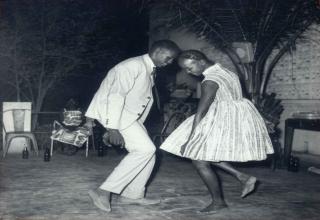




12 Comments